Compal Communications EB-G60U GPRS GSM Phone User Manual U COVER p65
Compal Communications, Inc. GPRS GSM Phone U COVER p65
users manual

Operating Instructions EB-G60U
Digital Cellular Phone
Before operating this equipment please read these instructions completely.
Important Information
i
Important Information
We, Matsushita Mobile Communications Development of Europe Ltd,
declare, that the EB-G60 conforms with the essential and other relevant
requirements of the directive 1999/5/EC. A declaration of conformity to
this effect can be found at http://www.panasonicmobile.com/support
Important Information
ii
THIS PANASONIC PHONE (MODEL EB-G60U) MEETS THE EU
REQUIREMENTS FOR EXPOSURE TO RADIO WAVES.
Your mobile phone is a radio transmitter and receiver. It is designed and
manufactured not to exceed the limits for exposure to radio-frequency
(RF) energy recommended by The Council of the European Union. These
limits are part of comprehensive guidelines and establish permitted levels
of RF energy for the general population. The guidelines were developed by
independent scientific organisations through periodic and thorough evalu-
ation of scientific studies. The limits include a substantial safety margin
designed to assure the safety of all persons, regardless of age and health.
The exposure standard for mobile phones employs a unit of measure-
ment known as the Specific Absorption Rate, or SAR. The SAR limit rec-
ommended by The Council of the European Union is 1.6 W/kg.* Tests
for SAR have been conducted using standard operating positions with
the phone transmitting at its highest certified power level in all tested
frequency bands. Although the SAR is determined at the highest certified
power level, the actual SAR level of the phone while operating can be
well below the maximum value. This is because the phone is designed to
operate at multiple power levels so as to use only the power required to
reach the network. In general, the closer you are to a base station antenna,
the lower the power output.
Before a phone model is available for sale to the public, compliance with
the European R&TTE directive must be shown. This directive includes as
one essential requirement the protection of the health and the safety for
the user and any other person. The SAR value for this model phone,
when tested for use at the ear, for compliance against the standard
was 1.0 W/kg averaged over a 10g mass. While there may be differ-
ences between the SAR levels of various phones and at various positions,
they all meet the EU requirements for RF exposure.
* The SAR limit for mobile phones used by the public is 1.6 watts/
kilogram (W/kg) averaged over ten grams of tissue. The limit
incorporates a substantial margin of safety to give additional
protection for the public and to account for any variations in
measurements. SAR values may vary depending on national re-
porting requirements and the network band.
Important Information
iii
FCC RF Exposure Requirements: For body-worn
operation, this phone has been tested and meets the
FCC RF exposure guidelines when used with COMPAL
accessories supplied or designated for this product.
Use of other accessories may not ensure compliance
with FCC RF exposure guidelines.
SAR standard limit is 1.6 W/kg
RF exposure FCC
Tests for SAR are conducted using standard operating positions
specified by the FCC with the phone transmitting at its highest
certified power level in all tested frequency bands. Although the
SAR is determined at the highest certified power level, the actual
SAR level of the phone while operation can be well below the
maximum value. This is because the phone is designed to operate
at multiple power levels so as to use only the power required to
reach the network. In general, the closer you are to a wireless
base station antenna, the lower the power output.
Before a phone model is available for sale to the public, it must
be tested and certified to the FCC that it does not exceed the
limit established by the government-adopted requirement for
safe exposure. The tests are performed in positions and
locations (e.g., at the ear and worn on the body) as required by
the FCC for each model. (Body-worn measurements may differ
among phone models,depending upon available accessories and FCC
requirements). While there may be differences between the SAR
levels of various phones and at various positions, they all meet the
government requirement for safe exposure.
Important Information
iv
For body worn operation, to maintain compliance with FCC RF
exposure guidelines, use only accessories that contain no metal-
lic components and provide a separation distance of 15mm (0.6
inches) to the body. Use of other accessories may violate FCC
RF exposure guidelines and should be avoided.
Health and Safety Information FCC
Exposure to Radio Frequency (RF) Signals
Your wireless phone is a radio transmitter and receiver. It is
designed and manufactured not to exceed the emission limits for
exposure to radio frequency (RF) energy set by the Federal Com-
munications Commission of the U.S. Government. These limits are
part of comprehensive guidelines and establish permitted levels
of RF energy for the general population. The guidelines are based
on the safety standards previously set by both U.S. and interna-
tional standards bodies:
This EUT has been shown to be capable of compliance for local-
ized specific absorption rate (SAR) for uncontrolled environment/
general population exposure limits specified in ANSI/IEEE Std. C95.
1-1992 and had been tested in accordance with the measure-
ment procedures specified in FCC/OET Bulletin 65 Supplement C
(2001) and IEEE Std. 1528-200X (Draft 6.5, January 2002).
Ministry of Health (Canada), Safety Code 6. The standards in-
clude a substantial safety margin designed to assure the safety
of all persons, regardless of age and health. The exposure stan-
dard for wireless mobile phones employs a unit of measurement
known as the Specific Absorption Rate, or SAR. The SAR limit set
by the FCC is 1.6W/kg *.

Important Information
v
* In the U.S. and Canada, the SAR limit for mobile phones used by
the public is 1.6 watts/kg (W/kg) averaged over one gram of
tissue. The standard incorporates a substantial margin of safety
to give additional protection for the public and to account for any
variations in.
Safety Considerations
The following information should be read and understood as it pro-
vides details which will enable you to operate your phone in a manner
which is both safe to you and your environment, and conforms to any
legal requirements regarding the use of cellular phones.
This equipment should only be charged with approved charg-
ing equipment. Other usage will invalidate any approval given
to this apparatus and may be dangerous. The use of approved
charging equipment is recommended to ensure optimum per-
formance and avoid damage to your phone. Ensure the voltage
rating of the Fast Travel Charger is compatible with the area of
use when travelling abroad.
A Fast Travel Charger is supplied with the Main Kit. Other rec-
ommended equipment for charging - Car Charger.
Switch off your cellular phone when in an aircraft. The use of
cellular phones in an aircraft may be dangerous to the opera-
tion of the aircraft, disrupt the cellular network and may be
illegal. Failure to observe this instruction may lead to the sus-
pension or denial of cellular phone services to the offender, or
legal action or both.
Do not incinerate or dispose of the battery as ordinary rubbish.
The battery must be disposed of in accordance with local legis-
lation and may be recycled.
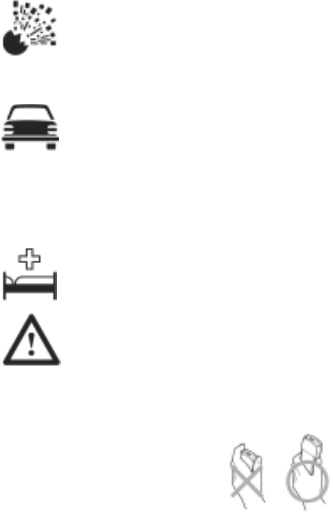
Important Information
vi
It is advised not to use the equipment at a refuelling point. Us-
ers are reminded to observe restrictions on the use of radio
equipment in fuel depots, chemical plants or where blasting
operations are in progress. Never expose the battery to ex-
treme temperatures (in excess of 60°C).
It is imperative that the driver exercises proper control of the
vehicle at all times. Do not hold a phone while you are driving;
find a safe place to stop first. Do not speak into a Handsfree
microphone if it will take your mind off the road. Always ac-
quaint yourself thoroughly with restrictions concerning the use
of cellular phones within the area you are driving and observe
them at all times.
Care must be taken when using the phone in close proximity to
personal medical devices, such as pacemakers and hearing aids.
For most efficient use hold the phone as you would any normal
phone. Your G60 cellular phone is fitted with an internal
antenna, located in the upper portion of the phone, back of the
display screen. To avoid deterioration of signal quality or an-
tenna performance, do not touch or “cup” the antenna area
while the phone is switched on.
Unauthorized modifications or attachments may damage the
phone and violate applicable regulations. The use of an unap-
proved modification or attachment may result in the invalida-
tion of your guarantee – this does not affect your statutory rights.
This Panasonic mobile phone is designed, manufactured and
tested to ensure that it complies with the specifications cover-
ing RF exposure guidelines applicable at the time of manufacture,
in accordance with EU, USA FCC, and Australian ACA
regulations.
Please refer to our website for latest information/standards
compliance in your country/region of use.
http://www.panasonicmobile.com/health.html

Care and Maintenance
vii
Care and Maintenance
Pressing any of the keys may produce a loud tone. Avoid hold-
ing the phone close to the ear while pressing the keys.
Extreme temperatures may have a temporary effect on the
operation of your phone. This is normal and does not indicate a
fault.
Do not modify or disassemble the equipment. There are no
user serviceable parts.
Do not subject the equipment to excessive vibration or shock.
Avoid contact with liquids. If the equipment becomes wet im-
mediately remove the power and contact your dealer.
Do not leave the equipment in direct sunlight or a humid, dusty
or hot area.
Keep metallic items that may accidentally touch the terminals
away from the equipment.
Always charge the battery in a well ventilated area, not in di-
rect sunlight, between +5°C and +35°C. It is not possible to
recharge the battery if it is outside this temperature range.
When connecting the phone to an external source, read the
operating instructions of the equipment for the correct con-
nection and safety precautions. Ensure the phone is compatible
with the product it is being connected to.
When disposing of any packing materials or old equipment check
with your local authorities for information on recycling.

Quick Reference
viii
Quick Reference
Press to select
Direction which the user can move around the display
screen using the Navigation key
Menu Representation of screen menu option
Secondary Softkey
Negative soft key/Back-key
-Numeric key pads
Answer a call or call a dialled number
Press to end a call or return to Idle screen.
Press and hold to switch the phone on or off.
Indicates that a function is SIM Dependent
Indicates that a function is Network Dependent
ix
Contents
Important Information ............................................................................................. i
Safety Considerations ....................................................................................... iii
Care and Maintenance ............................................................................................. v
Quick Reference ...................................................................................................... vi
Getting to Know Your Phone .................................................................................. x
Location of Controls ......................................................................................... x
Getting Started ....................................................................................................... 1
Fitting the SIM ................................................................................................... 2
Removing the SIM ............................................................................................. 2
Fitting the Battery .............................................................................................. 3
Removing the Battery ........................................................................................ 3
Charging the Battery ......................................................................................... 4
Operation of Battery Level Indicator ................................................................. 5
Low Battery Warning ........................................................................................ 5
Fitting Image-In ................................................................................................. 5
The Display ....................................................................................................... 6
Menu System Overview .................................................................................... 7
Selecting a Function ........................................................................................... 8
Basic Operation ..................................................................................................... 10
Switching On & Off ......................................................................................... 10
Making a Call ................................................................................................... 10
International Dialling ........................................................................................ 11
Emergency Calls .............................................................................................. 11
Ending a Call ................................................................................................... 11
Answering a Call ............................................................................................. 11
Caller Identification ......................................................................................... 12
Volume Control .............................................................................................. 12
Locking the Phone ........................................................................................... 12
Using the PIN .................................................................................................. 13
Setting Ring Volume ........................................................................................ 14
Setting Quiet Mode ......................................................................................... 14
Phonebook ............................................................................................................. 15
Browsing Phonebook ...................................................................................... 16
Retrieving a Number ....................................................................................... 16
Speed Dialling .................................................................................................. 17
Editing Phonebook Entries .............................................................................. 18
Synchronizing Phonebooks .............................................................................. 19
Review the Phonebook Status ......................................................................... 19
Grouping Phonebook Entries .......................................................................... 20
Info Dial and Service Dial ................................................................................ 22
My Numbers .......................................................................................................... 23
Personalising Your Phone ...................................................................................... 24
Changing the Language .................................................................................... 24
Add a Start-up Greeting .................................................................................. 24
Idle Screen Image ............................................................................................ 25
Changing Screen Saver Image .......................................................................... 26

x
Turning Screen Saver On & Off ....................................................................... 26
Colour Themes ............................................................................................... 27
Changing Sound Profiles .................................................................................. 27
Editing Sound Profiles ...................................................................................... 28
Download Data ( ) ........................................................................................ 29
Media Folders .................................................................................................. 29
Composing a Melody ...................................................................................... 30
Setting the Backlight Time ............................................................................... 31
Contrast .......................................................................................................... 31
Operator Notice ............................................................................................. 32
Restoring the Default Phone Settings .............................................................. 32
Phone Security ...................................................................................................... 33
Enabling Key Guard ......................................................................................... 34
Disabling Key Guard ........................................................................................ 34
Changing the Security Codes .......................................................................... 35
Restricting Calls ............................................................................................... 35
Applications ........................................................................................................... 37
Clock .............................................................................................................. 37
Setting the Time .............................................................................................. 37
Setting the Alarm ............................................................................................. 38
Muting the Alarm ............................................................................................ 39
Setting a Power On / Off Time ........................................................................ 39
Calculator ........................................................................................................ 40
Messaging ............................................................................................................... 41
SMS/EMS: Setting up the Phone ...................................................................... 42
Creating a Text Message .................................................................................. 44
Concatenated messages .................................................................................. 46
Receiving Text Messages .................................................................................. 46
Responding to Text Messages .......................................................................... 47
Chat SMS ........................................................................................................ 48
MMS: Setting Up the Phone ............................................................................ 49
MMS Configuration ......................................................................................... 50
Creating an MMS Message .............................................................................. 51
Managing Message Lists ................................................................................... 53
Cell Broadcasts ............................................................................................... 54
Call Information ..................................................................................................... 56
Recent Numbers ............................................................................................. 56
Call Duration ................................................................................................... 57
GPRS Call Duration ......................................................................................... 58
Call Charges .................................................................................................... 58
Setting the Unit Price ...................................................................................... 59
Setting the Maximum Unit Level ..................................................................... 59
Call Identification ............................................................................................. 60
Advanced Operation ............................................................................................. 61
Diverting Calls ................................................................................................. 61
Holding Calls and Call Waiting ......................................................................... 62
Making a Second Call ...................................................................................... 62
Receiving a Second Call ................................................................................... 63
Accepting a Second Call .................................................................................. 63
Rejecting a Second Call ................................................................................... 63
Ending Current Call to Receive Another ......................................................... 63
xi
Operation During Two Calls ............................................................................ 63
Call Transfer .................................................................................................... 64
Multi-party Calls .............................................................................................. 64
Changing to a New Network .......................................................................... 66
Schedule ................................................................................................................. 67
Creating a Reminder ....................................................................................... 67
Viewing & Editing Reminders .......................................................................... 68
Games ..................................................................................................................... 69
Embedded Games ........................................................................................... 69
Downloadable Games ..................................................................................... 69
Game Settings ................................................................................................. 70
Managing Multimedia Files .................................................................................... 71
Displaying Pictures and Animations ................................................................. 71
Playing Melodies .............................................................................................. 72
Renaming Files ................................................................................................. 72
Creating Mail from Files .................................................................................. 73
Deleting Files ................................................................................................... 73
Checking File Properties ................................................................................. 73
Checking Folder Properties ............................................................................. 74
WAP Browser ........................................................................................................ 75
Browser Settings ............................................................................................. 75
Activating the Browser .................................................................................... 78
Navigating Content ......................................................................................... 78
Browser Menu ................................................................................................ 79
Using Bookmarks ............................................................................................ 81
Deactivating the Browser ................................................................................ 82
Additional Features ............................................................................................... 83
Voice Memo .................................................................................................... 83
DTMF Tones ................................................................................................... 85
Note Pad ......................................................................................................... 85
Desktop Handsfree ......................................................................................... 86
Auto Answer ................................................................................................... 86
Camera Accessory ................................................................................................. 87
Taking a picture ............................................................................................... 87
Camera Accessory ................................................................................................. 87
Camera Options ............................................................................................. 88
Text Entry ............................................................................................................... 89
T9® Text Input ................................................................................................. 90
Other Text Modes ........................................................................................... 90
Editing Text ..................................................................................................... 90
Trouble Shooting ................................................................................................... 91
Important Error Messages ............................................................................... 93
Glossary of Terms ................................................................................................... 95
Specifications ......................................................................................................... 97
Phone (Including Battery) ................................................................................ 97
EU Warranty .......................................................................................................... 98
Personal Settings ................................................................................................. 104
Menu Structure ................................................................................................... 105
Note ..................................................................................................................... 106
Licensing ............................................................................................................... 107
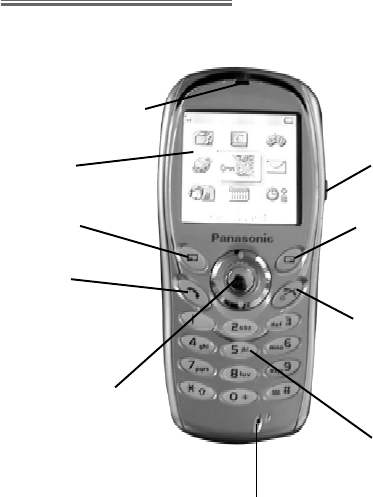
Getting to Know Your Phone
xii
Getting to Know Your Phone
Location of Controls
Earpiece
Display
Secondary Softkey
Call Key
Microphone Socket
Microphone
Primary Softkey
Negative Softkey
Power On/Off,
Back-Key
Keypad
Getting Started
Thank you for purchasing this Panasonic
digital cellular phone. This phone is designed
to operate on GSM networks – GSM850,
GSM1900. It also supports GPRS for packet
data connections. Ensure the battery is fully
charged before use.
Before operating this phone please read the
Important Information section - see page i.
These operating instructions detail use of the
equipment contained in the Main Kit.
Some services detailed are network dependent or
may only be available on a subscription basis.
Some functions are SIM dependent. For more
information contact your Service Provider.
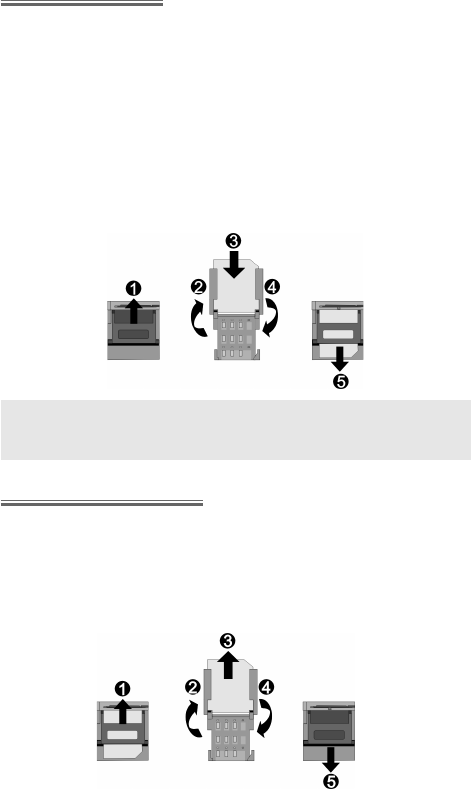
Getting Started
2
Fitting the SIM
The SIM is inserted into the back of the phone underneath the battery.
1 Remove the battery - see Removing the Battery page 3.
2 Unlock the SIM retainer by sliding it up towards the top of the
phone (X).
3 Gently raise the SIM retainer (Y).
4 Place the SIM into its recess, ensuring the bevelled corner is posi-
tioned in the top right corner (Z).
5 Move the SIM retainer back into position ([) and secure by sliding
downwards (\). The SIM retainer is properly locked when it has
clicked into position.
Note: Ensure the SIM retainer is properly locked into position. Fail-
ure to do so will inhibit the fitting of the battery and the battery cover.
Removing the SIM
1 Unlock the SIM retainer by gently pushing towards the top of the
phone (X).
2 Gently raise the SIM retainer (Y) and remove the SIM (Z). Return
the SIM retainer to its flat position ([) and ensure it is correctly
locked (\) before refitting the battery and battery cover.
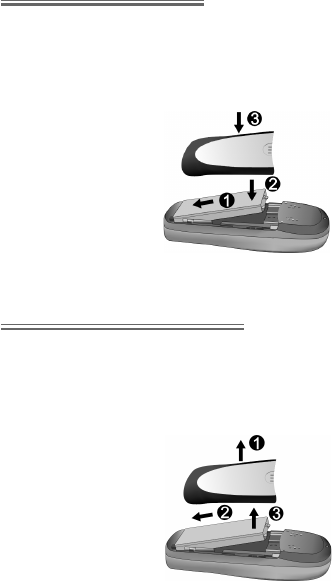
Getting Started
3
Fitting the Battery
1 Insert the battery bottom first so that the connectors touch those
on the phone.
2 Press gently downwards and simultaneously slot the top of the
battery into place.
Removing the Battery
Ensure the phone is switched off and the charger is disconnected from
the phone before removing the battery. Lever the battery out from the
notch in the top edge.
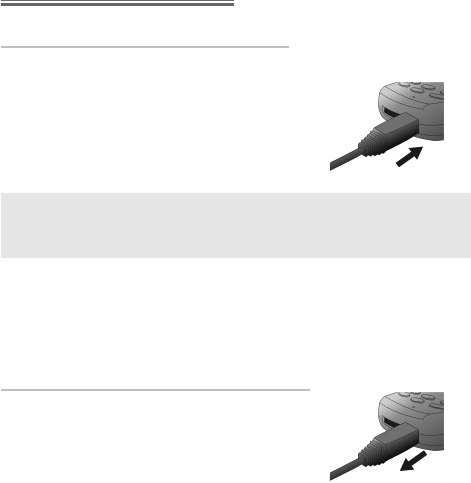
Getting Started
4
Charging the Battery
Connecting the Fast Travel Charger
The battery must be fitted in the phone before the charger is
connected.
Insert the connector into the base of the
phone, ensuring the arrow on the connec-
tor is to the front of the phone.
Note: DO NOT force the connector as this may damage the phone
and /or the charger.
Connect the charger to the mains power supply. The battery level indi-
cator will scroll right to left during charging.
Disconnecting the Fast Travel Charger
When charging is complete, disconnect the
charger from the mains power supply.
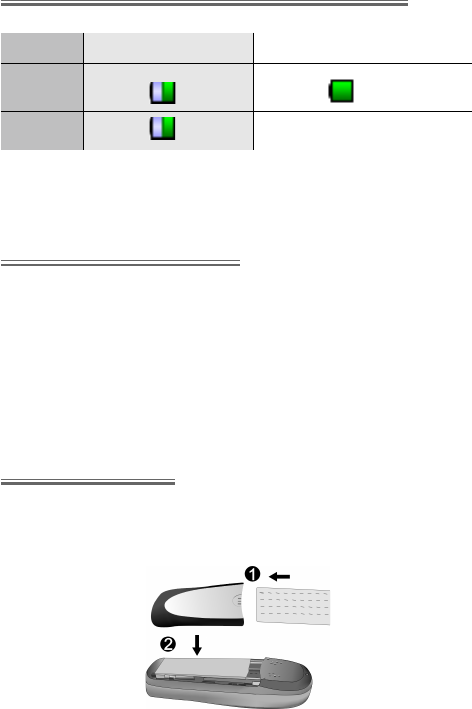
Getting Started
5
Operation of Battery Level Indicator
While charging Charging complete
Phone on
Phone off Charging indicator off
It is recommended that the battery is fully discharged between charges
to maintain optimum battery life and performance.
Low Battery Warning
When the battery power is low, the battery indicator will be coloured
red. If battery power is critically low, a warning tone will sound, and a
BATTERY IS EMPTY! message will be displayed. If this occurs during
conversation, finish your call immediately. The power will automatically
shut off after the warning tone. Fully recharge the battery. See Charging
the Battery, page 4. Calls can be made and received while the phone is
charging.
Fitting Image-In
Customised image cards may be fitted to the rear of the phone, behind
the transparent rear cover. An Image-In template is included with your
phone.
I
I
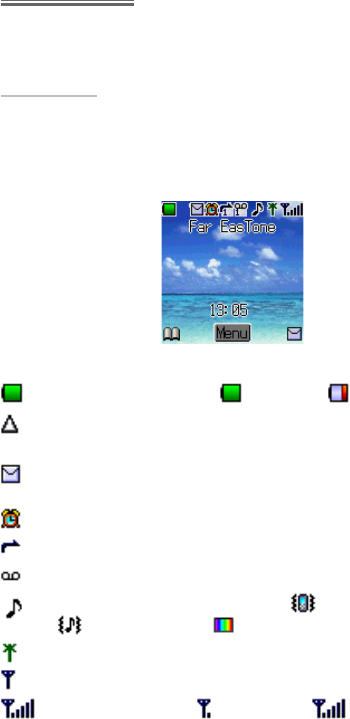
Getting Started
6
The Display
Following some operations the display will automatically clear after three
seconds or after pressing any key.
Status Icons
The status icons are displayed according to the currently activated
functions. The Antenna, Signal and Battery icons are displayed when the
handset is switched on and connected to a network.
Indicates Battery Level: (green)- full, (red) - low battery
Displayed when you are registered to a non-home network -
Roaming
White icon indicates a new message has been received. Red icon
indicates the message store is full.
Indicates Alarm is set
Indicates Call Divert is enabled
Voicemail activated
Indicates Ringer is enabled ( = vibration mode /
= vibrate + ring / = flashing mode)
Indicates GPRS service available
Indicates it is possible to make emergency calls only
GSM signal strength: - weak signal, - strong signal
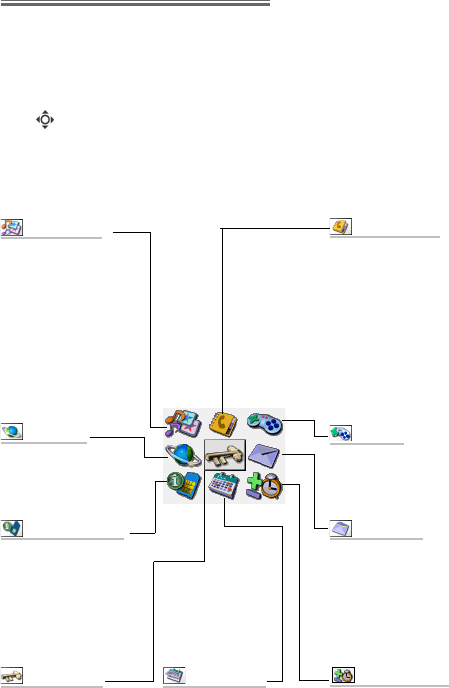
Getting Started
7
Menu System Overview
The menu system provides the means for accessing all the functions that
do not have their own dedicated buttons on the keypad. Each menu
contains a list of options. Some menus have further submenus.
The submenus and functions are selected using the five-way Navigation
key ().
The diagram below gives an overview of the contents of the menus to
help you find your away around. This is just a summary. Keep reading to
discover everything your phone has to offer.
My Phone
Set interface language
Choose ring tones and alert
method
Customize your colour scheme
Change idle screen picture and
screen saver
Phonebook
Create and manage your
phonebook
Group friends and contacts to
make their calls easy to identify and
their numbers easy to find
Put your closest friends and con-
tacts on your Hot Key Dial List for
instant dialling
Synchronise your SIM and Mobile
Phonebooks
Phone Option
Access security features and call
services
Set up call diversion
If an STK SIM card is fitted, this
menu gives access to operator-spe-
cific functions. The Phone Option
menu can also be accessed from
the Accessories menu.
Games
Access preinstalled and down-
loaded games. Availability of
downloadable games is network
dependent
Browser
Access and surf the Internet
Configure browser settings
Key Guard
Guard your phone against acciden-
tal use
Messages
Compose and send text and multi
media messages
Add sounds and images to mes-
sages
Scheduler
Add and view events in your personal
schedule
Applications
Download games (depending on
your network)
Record and listen to voice memos
Make use of built-in calculator,
write your own ring tones and
change clock settings
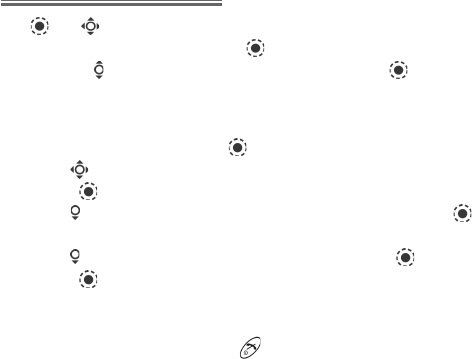
Getting Started
8
Selecting a Function
Use and to move between the icons on the screen. When a par-
ticular menu is highlighted, pressing displays a submenu. From any
submenu, use until the required item is highlighted. Press to select.
For example, to change Sound Setting (to switch ringtone):
1 From the Idle screen, press to display the main menu
2 Use to highlight the My Phone menu
3 Press to enter the menu
4 Use once to highlight the Sound Settings menu and press
to enter
5 Use to highlight the mode you wish to set and press to enter
6 Press to activate your chosen mode
Following some operations the display will automatically clear after three
seconds. If this is not the case press to return to the idle screen.

Getting Started
9
Shortcuts ( )
When familiar with the layout of the menu, use the keypad to enter the
Menu Number. This will allow the user to obtain the required function
without having to navigate through the display menus. To change Sound
Setting, for example, from the Idle screen, press to display the main
menu, then press 12 to enter the Sound Settings submenu.

Basic Operation
10
Basic Operation
This section contains the information you need for the most essential
phone operations, including:
DHow to switch on and off
DHow to make and end a call
DHow to answer a call
DHow to change earpiece volume
DHow to lock the phone
DHow to protect the phone using a PIN
DHow to change ring volume
Switching On & Off
To turn the phone on or off, press and hold down .
When the phone is switched on a greeting will be displayed and then the
phone will go into Idle. The Greeting can be set in the My Phone >
Display Settings > Greeting menu. See Adding a Start-up Greeting, page
24.
Making a Call
Ensure that the phone is switched on, the network operator logo is dis-
played and the signal strength meter shows network coverage is avail-
able in the current area.
1 Enter area code and phone number
2 Press
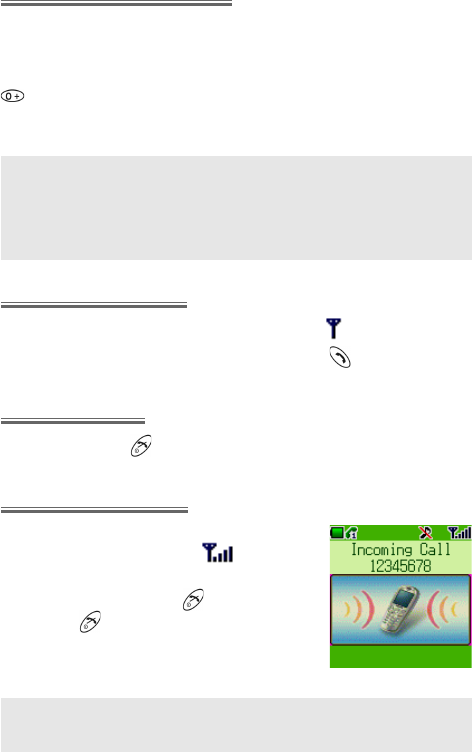
Basic Operation
11
International Dialling
The international code for the destination country / region should be
entered , followed by the area code and phone number.
To enter the international code, select an international line by pressing
until + appears, then enter the country / region code (e.g. 44 for the
UK; 81 for Japan).
Note: Many countries / regions include an initial “0” in the area code.
This should, in most cases, be omitted when dialling international
numbers. If you have difficulties making international calls, contact
your Service Provider.
Emergency Calls
To make an emergency call, the antenna symbol ( ) must be present.
To made an emergency call, enter 112 then press
Ending a Call
To end a call, press
Answering a Call
To receive a call, the phone must be switched
on and the signal strength meter must
be displayed.
Press any key except to answer a call
Press to reject a call
Note: If a call is not answered or is rejected, the number of incoming
calls missed will be displayed. Press any key to clear the display.
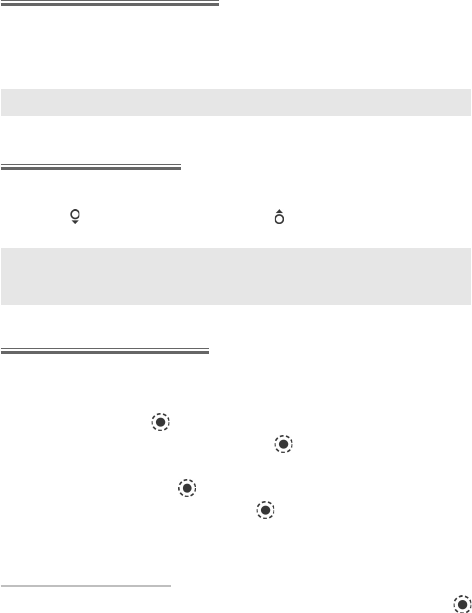
Basic Operation
12
Caller Identification
The caller’s phone number, and name if stored in the Phonebook, will be
displayed during an incoming call.
Note: Caller Identification may not always be available.
Volume Control
The volume level may be adjusted during a call:
Use to decrease the volume; use to increase the volume
Note: Volume control for the Personal Handsfree accessory is ad-
justed in the same manner.
Locking the Phone
With the Phone Lock enabled you will be restricted to answering incom-
ing calls only. The Phone Lock Code is factory set to 0000.
1 From Idle press and select (Applications >) Phone Option
> Security > Phone Lock. Press
2 From the submenu select Status
3 Select On and press
4 Enter the 4-digit code and press
The lock icon will be displayed in the primary selection area.
Unlocking the Phone
Enter your Lock Code. The lock icon will be replaced by OK. Press
to confirm.
As long as the Phone Lock is enabled, whenever you turn on the phone,
the Lock Code will need to be re-entered to activate the code.
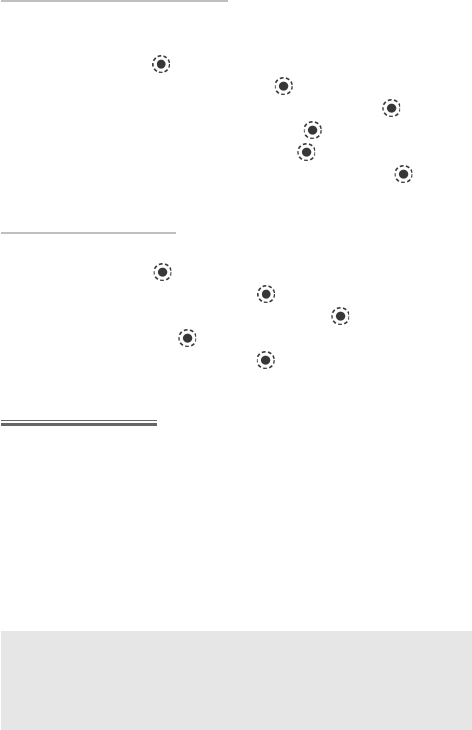
Basic Operation
13
Changing Phone Lock Code
You should change your phone lock code to a 4-digit number of your
own choice.
1 From Idle press and select (Applications >) Phone Option
> Security > Phone Lock. Press
2 From the submenu select Change Code and press
3 Enter the Old Unlock Code and press
4 Enter a New Unlock Code and press
5 Re-enter the New Unlock Code to confirm. Press to com-
plete the change.
Disabling Phone Lock
The phone must be unlocked before the phone lock can be disabled.
1 From Idle press , select (Applications >) Phone Option >
Security > Phone Lock. Press
2 From the submenu select Status and press
3 Select Off and press
4 Enter the 4-digit code and press
Using the PIN
The PIN protects your SIM against unauthorized use. If you enable the
PIN, every time the phone is turned on you will be prompted to enter
the PIN.
PIN2 controls security for the Fixed Dial Store, Call Charge metering
and Barred Dial list.
If either PIN/PIN2 is entered incorrectly 3 times the phone will be locked
and the user will need to enter the PUK/PUK2 code.
Contact your service provider for the PUK/PUK2 code.
Note: If the PUK/PUK2 code is entered incorrectly 10 times, the
SIM will cease to operate. All information stored in the SIM will be
lost and the SIM will need to be replaced. Contact your service pro-
vider for more details.
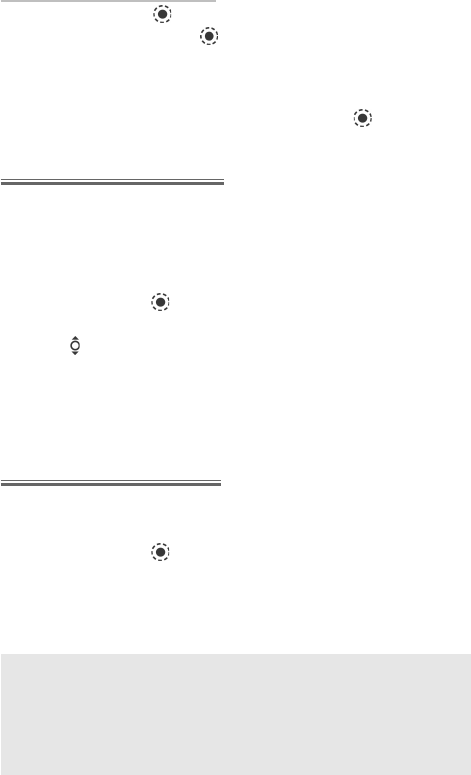
Basic Operation
14
Enabling/Disabling the PIN
1 From Idle press , select (Applications >) Phone Option >
Security > PIN. Press
2 Select Status
3 Select On or Off from the submenu
4 You will be prompted to enter the PIN. On first use, enter PIN of
your choice (Between 4 and 8 digits) and press
Setting Ring Volume
With the G60U, you can set up your phone in different modes depend-
ing on your environment, allowing different ring tones and volumes in
different situations.
To change ring volume for any sound profile:
1 From Idle press , select My Phone > Sound Settings
2 Select the profile you wish to adjust then select Edit > Ring Volume
3 Use to set the volume level
Turn to Personalising Your Phone, page 24, for more information on set-
ting different ring modes.
Setting Quiet Mode
You may wish to set at least one mode as a silent mode. To do this, set
Call Alert Method for that mode to Vibration:
1 From Idle press , select My Phone > Sound Settings
2 Select the profile you wish to adjust then select Edit > In-Call
Alerting
3 Select Vibration
Note: Once you have set the ring volume / type for a mode, you can
make that the active mode at any time by selecting My Phone >
Sound Settings, choosing the desired mode then choosing Activate.
Turn to Personalising Your Phone, page 24, for more information on
setting different ring modes.
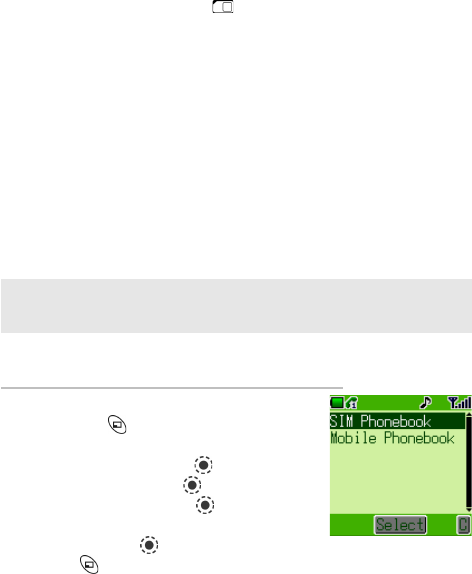
Phonebook
15
Phonebook
Phone numbers can be stored in two locations:
In the SIM Phonebook ( ), where the number of entries and
lengths of names and numbers are SIM dependent.
In the Mobile Phonebook, where phonebook entries can be
grouped together and additional data can be stored with numbers.
This phonebook is retained even if you change your SIM.
This section tells you all you need to know about:
DManaging your Phonebooks
DFinding entries in your Phonebooks
DSpeed Dialling
DGrouping Phonebook entries to make calls easier to identify and
numbers easier to find
Note: See Text Entry, page 84, for information on text entry meth-
ods available for making Phonebook entries.
To Store a Number in the SIM Phonebook
1 From Idle enter the phone number
and press
2 From the menu select SIM
Phonebook and press
3 Select Name, press and enter
identifying name. Press
4 Select No. and confirm the phone
number. Press
5 Press to save
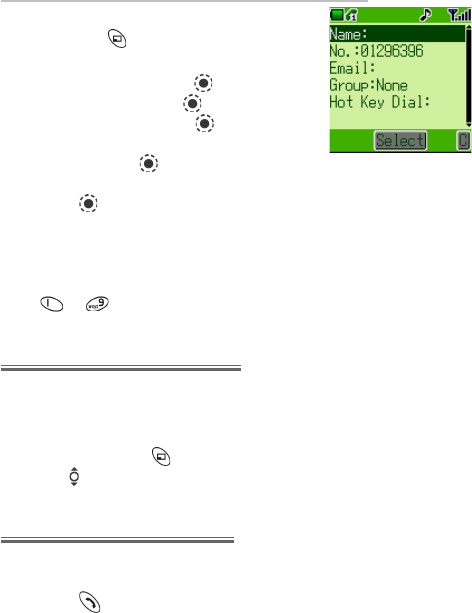
Phonebook
16
To Store a Number in the Mobile Phonebook
1 From Idle enter the phone number
and press
2 From the menu select Mobile
Phonebook and press
3 Select Name, press and enter
identifying name. Press
4 Select No. and confirm the phone
number. Press
5 Select and enter Email address.
Press (optional)
6 Select a Group - see Grouping
Phonebook Entries - into which to
place the entry (optional)
7 Enter a Hot Key Dial number from
to (optional)
Browsing Phonebook
You can browse both Phonebooks simultaneously by name. Use the di-
rection keys to move through the contact list or press a lettered key to
skip to the first entry starting with that letter.
1 From Idle press
2 Use (or the lettered keys) to select the entry you wish to browse
Retrieving a Number
1 Browse to locate and highlight the desired number in the
Phonebooks
2 Press to dial the number
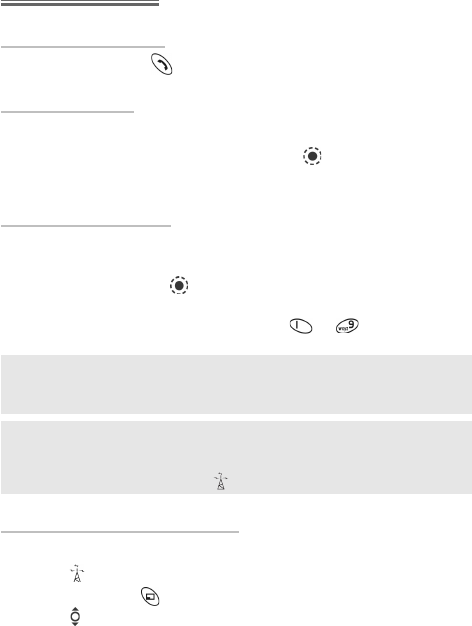
Phonebook
17
Speed Dialling
Last Number Called
From Idle press twice
Hot Key Dialling
From Idle press and hold the appropriate hot key number.
To view your hot key dial list, from Idle press , select Phonebook >
Hot Key Dial List
Assigning Hot Keys
To assign a hot key to a frequently used number:
1 Browse to locate and highlight the desired number in the
Phonebooks. Press
2 Select Edit > Hot Key Dial
3 Enter the Hot Key dial number (from to ) for this entry
Note: If the Hot Key number is already taken, an ID Used message
will appear.
Note: Some Hot Key Phone numbers may be reserved by the Ser-
vice Provider. For example the first three Hot Key Phone numbers
may be linked to Service Dial ( ).
Info Numbers or Service Dial
Your Service Provider may program some special phone numbers into
your SIM ( ). It is not possible to modify these:
1 Press and hold
2 Use to browse through the Service Dial list of phone numbers
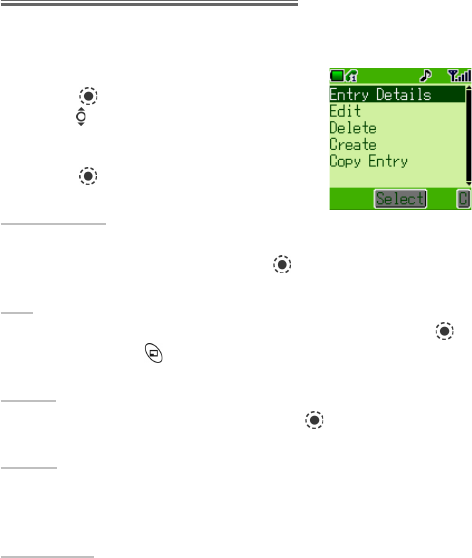
Phonebook
18
Editing Phonebook Entries
It is possible to view Entry Details, Edit, Delete, Create or Copy
Entry information from the Phonebooks. To access any of these functions:
With a phone number or name highlighted:
1 Press to select the submenu
2 Use to cycle through Entry
Details, Edit, Delete, Create or
Copy Entry
3 Press to select an option
Entry Details
Displays each element of the selected Phonebook entry: Name, number
and location of entry (SIM or phone). Press to edit the name or number.
Edit
Displays the entry allowing you to make changes as required. Press to
save any changes and when you have completed editing.
Delete
Deletes the entry from the Phonebook. Press to confirm deletion.
Create
Creates a new entry in the Phonebooks. Select SIM Phonebook or Mo-
bile Phonebook as entry location.
Copy Entry
Use to copy an entry between Phonebooks.
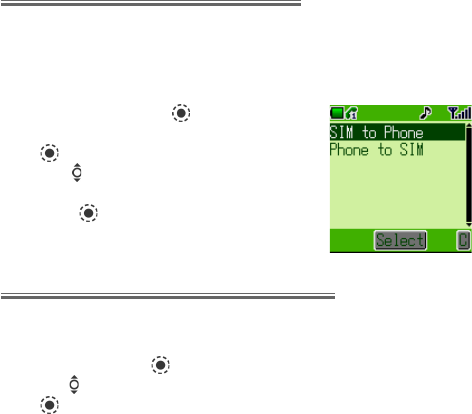
Phonebook
19
Synchronizing Phonebooks
Keep your SIM and Mobile Phonebooks in step by synchronizing their
contents regularly. You can copy individual entries between phonebooks
(see Editing Phonebook Entries, page 18) or simply copy the entire con-
tents of one phonebook into the other. To do this:
1 From Idle, press and select
Phonebook > Copy Entries. Press
2 Use to either copies the entries
of SIM to Phone or Phone to SIM.
Press to select
Review the Phonebook Status
The Review function in the Phonebook menu shows how many locations
are available in the two Phonebooks.
1 From Idle press , select Phonebook > Review
2 Use to select SIM Phonebook or Mobile Phonebook and press
A summary of the selected Phonebook will be displayed.
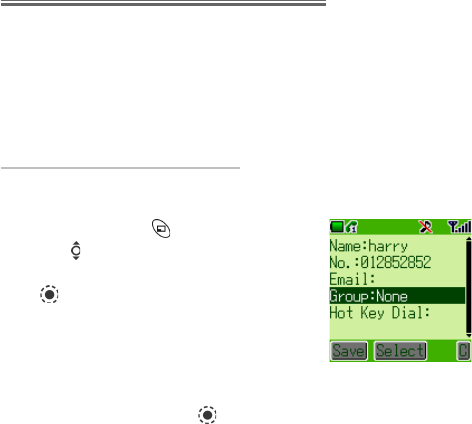
Phonebook
20
Grouping Phonebook Entries
Groups are used to collect together types of Phonebook entries, for
example business and personal. Each group can be suitably titled for quick
access to the entries contained within.
An alert profile can be attributed to groups (or individual phone numbers)
allowing incoming call alerts to be tailored to indicate the type of caller.
Adding a Number to a Group
You can store numbers in up to 10 groups. To add a number from your
Mobile Phonebook to a group:
1 From Idle press
2 Use (or the lettered keys) to se-
lect the entry you wish to add. Press
to reveal the submenu
3 Select Edit. If the entry is stored in
the Mobile Phonebook, its group
location will be shown (Group:
None is displayed if the number
does not belong to a group)
4 Select Group and press
5 Scroll through the list of available
groups and select whichever is ap-
propriate
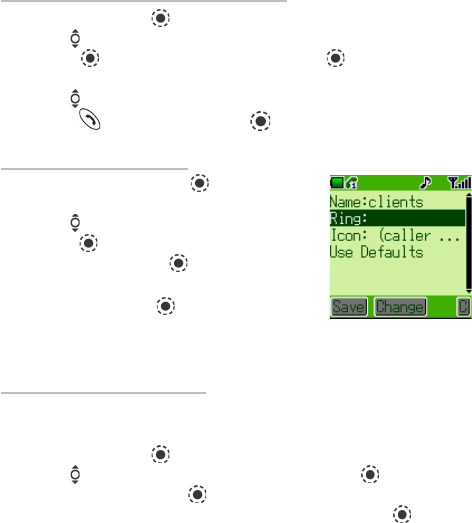
Phonebook
21
Retrieving a Number from a Group
1 From Idle press , select Phonebook > Group Setting
2 Use to select the group
3 Press to enter the submenu and press again to View the
contents of the group
3 Use to select the desired entry
4 Press to dial the number or to edit the details of the entry
Retitling Group Names
1 From Idle press , select
Phonebook > Group Setting
2 Use to select the group
3 Press to enter the submenu, se-
lect Edit and press again
4 Name is highlighted at the top of the
submenu. Press once to start
editing the name and a second time
to confirm
Setting Group Ring Tones
Each group can be given a distinct Alert Profile so that incoming calls are
recognizable from their ring tone. To set a group’s ring tone:
1 From Idle press , select Phonebook > Group Setting
2 Use to select the group, select Edit and press again
3 Select Ring and press again
4 Scroll through and select the desired ring tone. Press to select
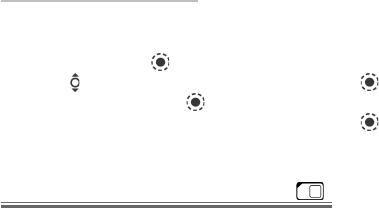
Phonebook
22
Setting Group Call Icons
You can also attach to a group an image that will display when a call is
received. To add an image:
1 From Idle press , select Phonebook > Group Setting
2 Use to select the group, select Edit and press again
3 Select Icon and press again
4 Scroll through and select the desired icon. Press to select
Info Dial and Service Dial ( )
The Info Dial and Service Dial items on the Phonebook menu provide
space for operators to include useful numbers. If your operator does not
offer these services, these spaces will be blank.
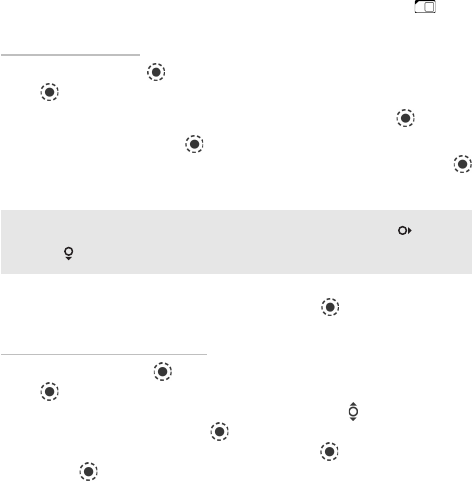
My Numbers
23
My Numbers
My Numbers is a convenient part of the Phonebook where your own
voice, fax and data phone numbers can be stored and viewed ().
Adding Numbers
1 From Idle press and select Phonebook > My Numbers. Press
2 Select an empty entry from the list of numbers. Press
3 Select Edit and press
4 Select and enter the Name (see Text Entry, page 84) and press
to save
Note: If using T9® text input (recommended) then move before
moving otherwise an alternative word will be selected.
5 Select and enter the phone No. and press twice
Viewing Stored Numbers
1 From Idle press , select Phonebook > My Numbers. Press
2 If more than one number is available then use to cycle through
the listed numbers. Press to select
3 Select Entry Details to view entry. Press
4 Press again if you wish to edit the details
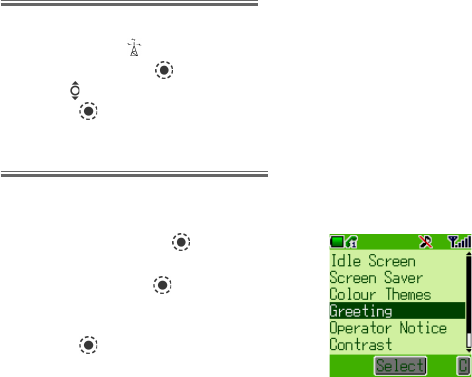
Personalising Your Phone
24
Personalising Your Phone
This section contains all the information you need to adapt your phone
to your needs and personality. You can:
DChange the menu language
DAdd a message to show at start-up
DTry a new idle screen image
DChange your screen saver image
DUse a different colour theme
DSwitch between and edit different user profiles
DMake use of downloaded ring tones and images
DCompose your own ring tone
DChange the backlight and contrast settings
...and more!
Changing the Language
It is possible to change the language the phone uses for display messages
and /or text entry ( ) .
1 From Idle, press , select My Phone > Language
2 Use to select the Language you wish to use
3 Press to select the desired language
Add a Start-up Greeting
A personalised greeting can be programmed for when the phone is
switched on.
1 From Idle press , select My
Phone > Display Settings >
Greeting. Press
2 Use the text entry facility to add a
greeting (see Text Entry, page 84).
Press to confirm
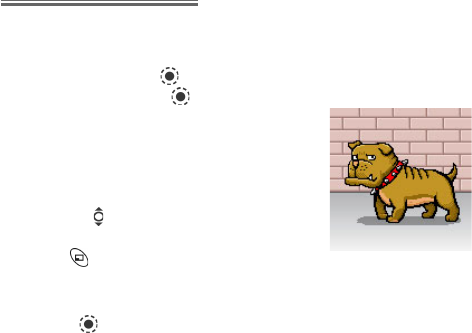
Personalising Your Phone
25
Idle Screen Image
The idle screen can be changed to a preinstalled or downloaded image.
To choose an image for the Idle screen:
1 From Idle press , select My Phone > Display Settings >
Idle Screen. Press
2 Several images are preinstalled on
your phone in the Fixed Data
folder. Downloaded images are
stored in the User Data folder.
Navigate to the appropriate folder
and use to select the required im-
age
3 Use to view image. Press any key
to return
4 Highlight the image you want and
press to select

Personalising Your Phone
26
Changing Screen Saver Image
The screen saver can also be changed to a preinstalled or downloaded
image.
To choose an image for the screen saver:
1 From Idle press , select My Phone > Display Settings >
Screen Saver. Press
2 Several images are preinstalled on
your phone in the Fixed Data
folder. Downloaded images are
stored in the User Data folder.
Navigate to the appropriate folder
and use to select the required im-
age
3 Use to view image. Press any key
to return
4 Highlight the image you want and
press to select
Turning Screen Saver On & Off
Select My Phone > Display Settings > Screen Saver > Setting to
turn the screen saver function On or Off, and to set the Idle Time (from
1 to 5 minutes) before the screen saver is launched.
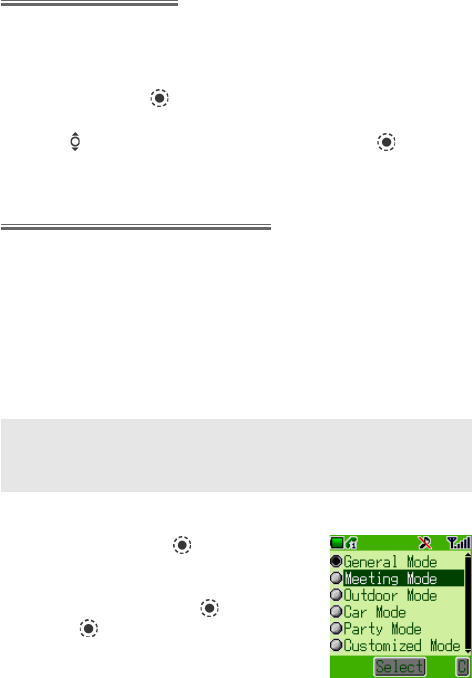
Personalising Your Phone
27
Colour Themes
Colour Themes provide alternative combinations of colours for the back-
ground and text.
To use or change a Colour Theme:
1 From Idle press and select My Phone > Display Settings >
Colour Themes
2 Use to select the required Colour Theme. Press
Changing Sound Profiles
You can switch between six sound profiles on your phone each with a
distinct combination of alert method, ring tone and type etc.
Profiles are set up for use in different environments - for instance you
might want to create a silent profile, a discreet profile with ring tone
appropriate for formal occasions and a party profile for loud environments.
Within each profile, distinct melodies can be set as incoming call and
message alerts.
Note: Ring tones can also be used to identify incoming calls from
members of groups. If a group member calls, the Group ring tone
will sound, not the Sound Profile ring tone.
To activate a Sound Profile:
1 From Idle press select My
Phone > Sound Settings
2 Select the Profile you wish to acti-
vate from the list. Press
3 Press again to activate that Pro-
file
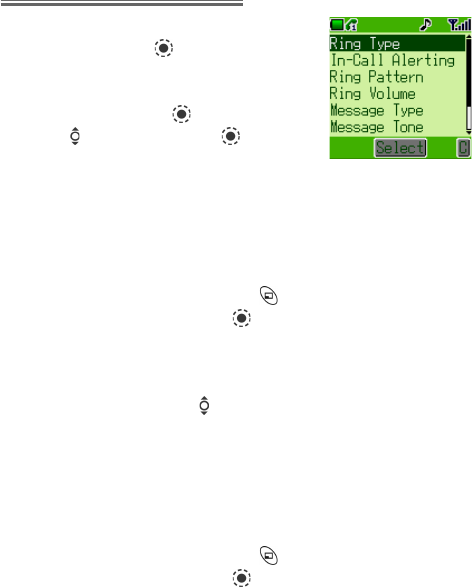
Personalising Your Phone
28
Editing Sound Profiles
To edit a Profile:
1 From Idle press and select My
Phone > Sound Settings
2 Select the Profile you wish to edit
from the list. Press
3 Use to select Edit. Press
For each profile, you can set and edit the following:
Ring Type Select a ring tone from the lists of preinstalled
melodies (Fixed Data) or downloaded melo-
dies / ring tones that you have written (User
Data). Press to preview the ring
tone and to confirm ring tone selection
In-Call Alerting Select from Ringer / Vibration / Vibration
and Ring / Flashing / Off
Ring Pattern Select either Continuous or Once
Ring Volume Use to set the volume level. To mute volume,
use the In-call Alerting submenu
Message Type Select the alert type for incoming message
(Ringer / Vibrate and Ring / Off)
Message Tone Select a ring tone from the lists of preinstalled
melodies (Fixed Data) or downloaded melo-
dies / ring tones that you have written (User
Data). Press to preview the ring
tone and to confirm ring tone selection
Keypad Tone Turn keypad tones On or Off
Warning Tone Turn warning tones (which sound if an inap-
propriate key stroke is made) On or Off
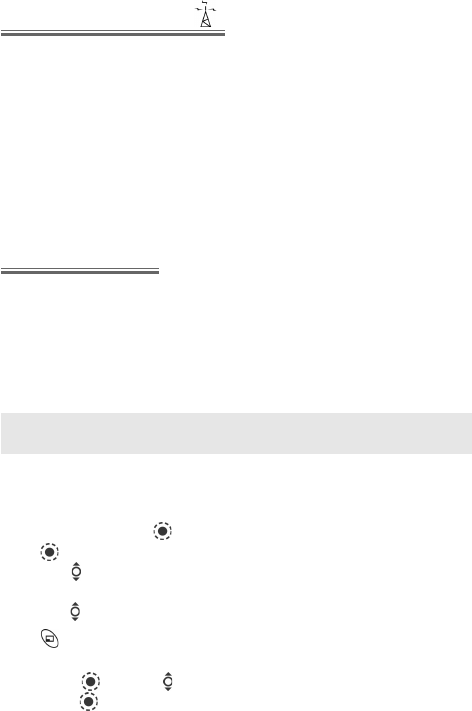
Personalising Your Phone
29
Download Data ( )
The Panasonic G60U is able to use various downloaded data. The down-
loaded data is stored in the Media Folder and can be acquired via MMS,
EMS, SMS or WAP. Details of this service are available on our website.
Availability of this service is dependant on your country/region, or
network.
For further information visit:
http://www.panasonicbox.com
Media Folders
The Media Folder located at My Phone > Media Folder is the storage
location for media files that have been downloaded from a third party
source and are saved in the handset. Some of these can be used as ring
tones, Idle screen images or attachments to text messages. See Manag-
ing Multimedia Files, page 69, for how to use these files.
Note: It is only possible to attach EMS format Animations/Pictures
Access these files from the Media Folder menu to rename, delete or edit
them. To select an item from the Media Folder:
1 From Idle, press select My Phone > Media Folder and press
2 Use to select the media type (either Picture, Animation or
Melody)
3 Use to select a file
Press to view or play the selected file before making any changes to
the file.
4 Press and use to select Rename, Delete or Delete All.
Press
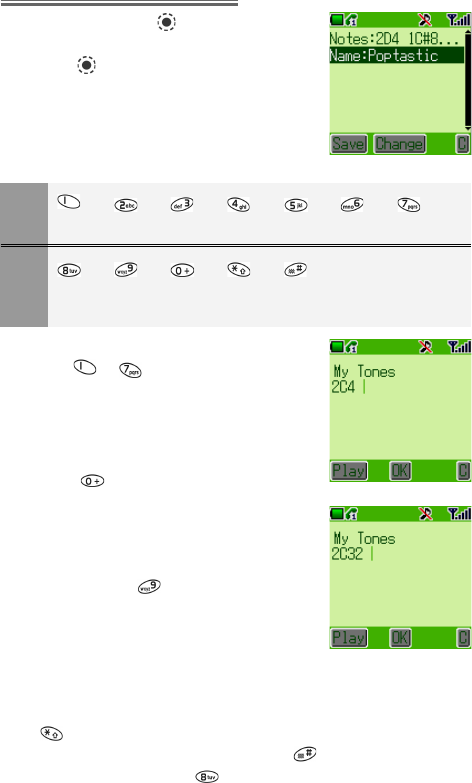
Personalising Your Phone
30
Composing a Melody
1 From Idle, press , select Appli-
cations > Edit Ringtone
2 Press and then select New Tone.
Using the table below as reference, enter
the notes, set the rhythm and octave for
each and add rests to generate your
composition.
Key
Note CDE F GAB
Key
Note Rest Note Set Dotted Sharp
Length Octave Note
3 Referring to the table above, use the
keys to to enter notes.
4 The notes appear in the format 2C4
as shown on the right.
DThe first number (2) indicates the
note octave. The default value is 2.
Press to change octave (range
from 1 to 3).
DThe number of the right (4 in the
first picture on the right) indicates
the notes length. The default value
is 1/4. Press to change note
length (range from 1 to 1/32).
DIn the second picture on the right,
the octave has been left unchanged
at 2 while the note length has been
shorted to 1/32.
DIndicate dotted notes (i.e. notes extended in length) by pressing
.
DAdd sharp values to notes by pressing .
DEnter rests by pressing .
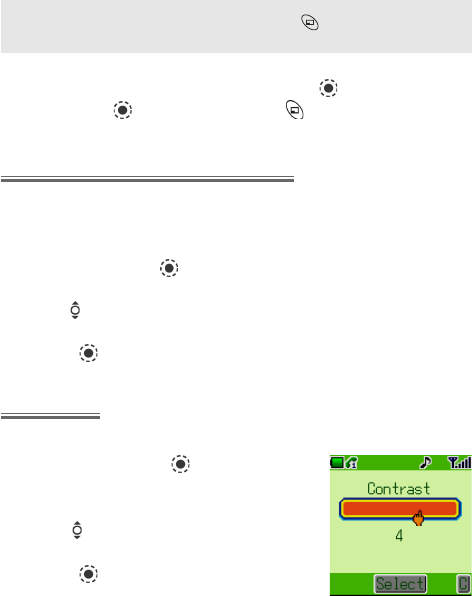
Personalising Your Phone
31
Note: At any time during composing press to play back the cur-
rent melody.
5 When the composition is complete, press twice and enter the
title. Press to save the name and to complete composing.
Setting the Backlight Time
The Backlight is illuminated when a key is pressed to make using your
phone easier. You may wish to reduce backlight time to increase the
time your phone will run between battery charges.
1 From Idle, press , select My Phone > Display Settings >
Backlight Time
2 Use to cycle through the times available (Off / 10 seconds / 30
seconds / 60 seconds)
3 Press to select the desired time
Contrast
Screen contrast can be altered for viewing in different lighting conditions:
1 From Idle, press , select My
Phone > Display Settings > Con-
trast
2 Use to set the desired contrast
level
3 Press to confirm selection
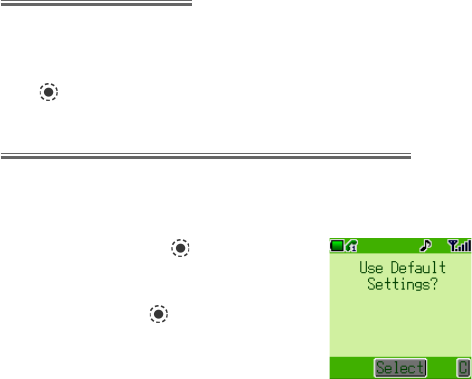
Personalising Your Phone
32
Operator Notice
Operator notices appear if the phone has been left idle to remind users
how to operate selected features. To enable and disable operator no-
tices go to My Phone > Display Settings > Operator Notice and
press .
Restoring the Default Phone Settings
Any personal settings can be swiftly returned to their factory default,
with the exception of some features, such as the Phone Lock code and
the Language.
1 From Idle, press , select My
Phone > Defaults
2 When prompted Use Default
Settings? press to confirm and
restore the settings

Phone Security
33
Phone Security
Your phone has a number of security features that protect against unau-
thorized use and enable the user to restrict access to certain functions.
These include:
DPhone Lock
DPIN Protection
DKey Guard
DCall Barring
DFixed Dial
Note: For full details of the Phone Lock feature, turn to Locking the
Phone, page 12.
Note: For full details of PIN Protection, turn to Using the PIN, page
13.
It is recommended that all security codes are memorized. If it is neces-
sary to make a note of any security codes, never write them in a way that
they can be recognized by another person. If forgotten, contact your
dealer (for the Phone Lock Code) or Service Provider (for PIN and PIN2).
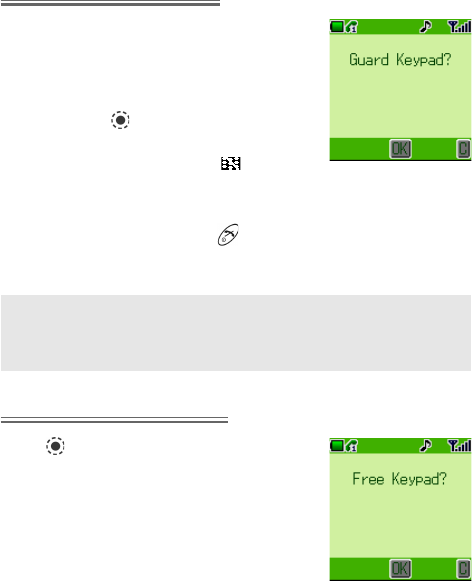
Phone Security
34
Enabling Key Guard
The Key Guard function is used to pre-
vent any keys from being accidentally
pressed, for instance when the phone is
being carried.
From Idle press twice to bring up the
Guard Keypad? message and a third time
to confirm. The Key Guard icon ( ) will
appear on the Idle screen
When a call is received, Key Guard will be disabled temporarily, allowing
the user to press any key except to answer the call. Emergency calls
can still be made - see Emergency Calls, page 11.
Note: When making emergency calls with the “Key Guard” enabled,
there will be no audible or visual indication that the number is being
dialled
Disabling Key Guard
Press once to bring up the Free
Keypad? message and a second time to
confirm.
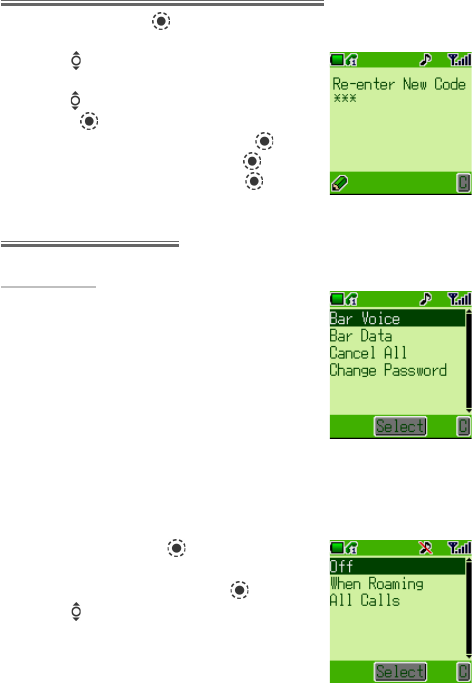
Phone Security
35
Changing the Security Codes
1 From Idle press and select (Applications >) Phone Option
> Security
2 Use to select Phone Lock, PIN
or PIN2
3 Use to select Change Code and
press
4 Enter the current code and press
5 Enter the new code and press
6 Verify the new code and press
Restricting Calls
Call Barring
The Call Bar function is used to restrict
certain outgoing and/or incoming calls. Call
Barring is controlled by a security pass-
word that is supplied by the Service Pro-
vider (this password can be changed: see
below). When updating or checking the
status of Call Barring the phone must be
registered with a network. Different Call
Bar restrictions can be used for voice and
data calls. Any combination of call restric-
tions can be set.
1 From Idle press and select
(Applications >) Phone Option >
Security > Call Bar. Press
2 Use to select Bar Voice or Bar
Data
3 Follow the submenus to set the de-
sired restrictions

Phone Security
36
Outgoing Calls Select from All Calls / International Calls /
International Calls Except Home / Off
Incoming Calls Select from Off / When Roaming / All Calls
Data Calls Select from All Calls / International Calls /
International Calls Except Home / Off
4 Enter Call Bar password and press
Note: To change Call Barring password, go to (Applications >)
Phone Option > Security > Change Password
You can change individual Call Barring settings following the instructions
above or cancel all call barring settings by selecting (Applications >)
Phone Option > Security > Cancel All.
Fixed Dial
The Fixed Dial Store is part of Phonebook (Phonebook > Fixed Dial),
but with additional security.
When the security feature Fixed Dial is enabled in the security submenu
it is only possible to make calls with phone numbers that are in the Fixed
Dial Store. When Fixed Dial is enabled any manually dialled phone num-
bers must match a phone number in the Fixed Dial Store.
To store, edit or delete a phone number in the Fixed Dial Store the Fixed
Dial function must be enabled. With Fixed Dial enabled, all phone num-
bers can be added, edited or deleted as normal, but you will be prompted
for PIN2.
To enable Fixed Dial:
1 From Idle press and select (Applications >) Phone Option
> Security > Fixed Dial. Press
2 You will be prompted to enter SIM PIN2 before proceeding.
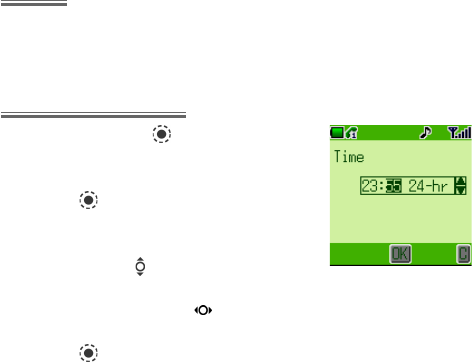
Applications
37
Applications
This section introduces some of the applications you’ll find installed on
your phone. These include:
DThe clock
DAlarms
DAutomated power on and power off
DThe calculator
Clock
Your phone incorporates a clock with date/time, an alarm and an auto-
matic power on/off feature.
Setting the Time
1 From Idle press and select Ap-
plications > Clock Function >
Clock Set
2 Press to select the time entry
3 Use the numbered keys to enter the
correct time (using the 24-hour
clock) or use to adjust the time
displayed. Move between the hour
and minute fields using
4 When the time is entered correctly,
press to confirm
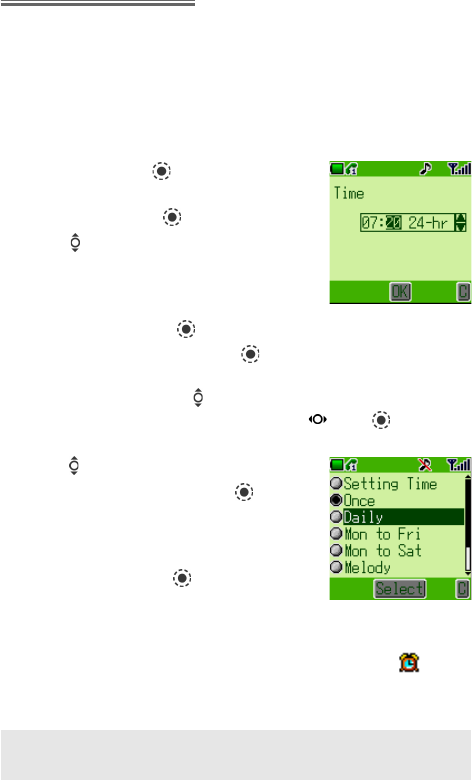
Applications
38
Setting the Alarm
Up to three separate alarms can be set. For each alarm, you can set
different schedules (e.g. daily / weekdays only) and alarm tones as well as
times.
If the clock hasn’t been set, the user will be prompted to set it prior to
setting the alarm.
To set an alarm
1 From Idle press and select Ap-
plications > Clock Function >
Alarm Set. Press
2 Use to select the alarm to be set
(By default the alarms are named
Alarm1, Alarm2 and Alarm3.
These names can be changed -- see
step 7 below). Press
3 First set the alarm time. Press to enter Setting Time
4 Use the numbered keys to enter the correct alarm time (using the
24-hour clock) or use to adjust the time displayed. Move be-
tween the hour and minute fields using Press when com-
plete
5 Use to highlight the desired sched-
ule for the alarm and press to
select
6 Select Melody and highlight and se-
lect the desired alarm melody from
the submenu. Press to confirm
7 Select Rename and enter a name
for the alarm setting
When the alarm has been set, and the clock is displayed, will be
displayed when the phone is in Idle.
Note : To disable an alarm setting, select Applications > Clock
Function > Alarm Set > [Alarm Name] > Cancel
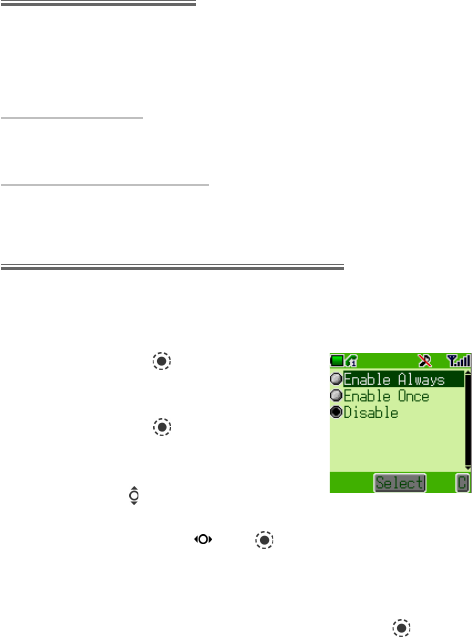
Applications
39
Muting the Alarm
When an alarm goes off, the chosen melody will sound and the display
will flash with an alarm message. The alarm will sound for 30 seconds. If
the alarm is due during a call, it will activate a vibration alert.
To end the alarm:
Press any key
Adjusting the Alarm Time
To adjust an alarm time follow the steps in Setting the Alarm, page 38.
Setting a Power On / Off Time
The phone can be set to turn itself on or off automatically at a specified
time using the Power On / Off feature. To set the Power On and Off
schedule:
1 From Idle press and select Ap-
plications > Clock Function
2 Select Power On Time or Power
Off Time. Press
3 Use the numbered keys to enter the
correct Power On or Power Off
time or use to adjust the time
displayed. Move between the hour
and minute fields using Press
when complete
4 The Power On / Power Off setting can be applied once when the
set time is next reached (Enable Once) or until cancelled (Enable
Always). Highlight the appropriate setting and press to select
is similar to that for setting the time on the clock. For either setting
or adjusting the time needed to select Power On Time or Power
Off Time in the Clock Function menu
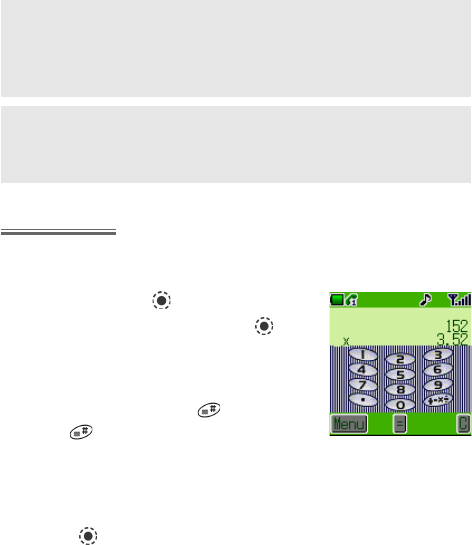
Applications
40
Caution: Ensure that the setting of the Alarm or Power On function
will not contravene any regulations whereby it may automatically
power on when in an aircraft or medical facility etc. - see Important
Information, page I.
Note : To disable a Power On or Power Off setting select Applica-
tions > Clock Function > Power On Time / Power Off Time >
Time (ignore) > Disable.
Calculator
The four function calculator will enable the user to perform simple arith-
metic calculations (addition/subtraction/multiplication and division).
1 From Idle press and select Ap-
plications > Calculator. Press
2 Enter a number (maximum 8 digits)
and it will be displayed on the up-
per right of the display. If a decimal
point is required, press
3 Use to scroll through and select
the arithmetic operation you wish to
perform
4 Enter a second number (maximum 8 digits). It will be displayed
next to the operation symbol
5 Press to complete the calculation
Messages
41
Messaging
Your phone has various messaging features including SMS, MMS and EMS.
SMS/EMS - Enter the recipient’s phone number to send text and images.
MMS - Attach images and music to text messages.
This chapter is a full introduction to messaging including:
DSetting up your phone to enable SMS/EMS and MMS messaging
DWriting text messages
DSending Quick Notes
DAdding attachments to text messages
DReading incoming messages
DManaging messages in your Inbox and Outbox
DChatting with SMS contacts
DCreating multimedia messages
DReceiving message broadcasts on desired topics
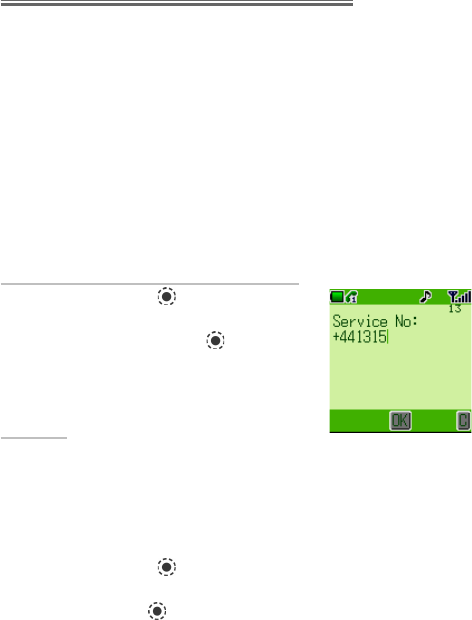
Messages
42
SMS/EMS: Setting up the Phone
It is possible to receive, display, edit and/or send text messages of up to
459 characters (dependent upon the language being used) to mobile
phones on your service provider’s network or any network that has a
roaming agreement (dependent on the recipient’s phone parameters).
Before a text message can be sent, you must enter the Message Centre
number into Options (your Service Provider will supply the Message Cen-
tre number). You should also select the protocol via which messages are
sent, the storage time (lifetime) and pick a delivery confirmation setting.
The Message Centre number may have been pre-programmed on the
SIM.
Setting the Message Centre Number
From Idle press , select Mes-
sages > Options > SMS/EMS >
Message Centre. Press
Include the international dialling code in the
Message Centre number.
Lifetime
The lifetime is the duration that your mes-
sages are stored at the Message Centre.
Delivery attempts will be repeated until
the message has been delivered or the
Lifetime expires.
From Idle press , select Mes-
sages > Options > SMS/EMS >
Lifetime. Press
Select from 1 hour, 12 hours, 1 day, 1
week or Maximum to set the time after
which messages are automatically deleted.
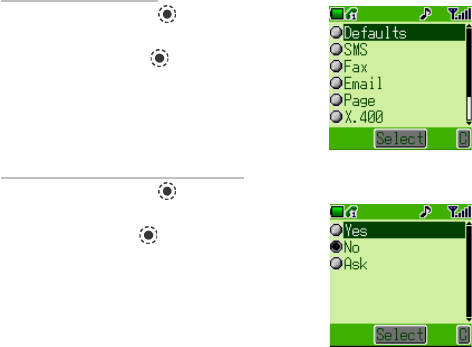
Messages
43
Messaging Protocol
From Idle press , select Mes-
sages > Options > SMS/EMS >
Protocol. Press
Select the appropriate protocol for send-
ing messages or maintain the Default
setting.
Delivery Confirmation Setting
From Idle press , select Mes-
sages > Options > SMS/EMS >
Report. Press
Select Yes to enable delivery confirmation
for your messages, No to disable the func-
tion and Ask to prompt the message re-
cipient to acknowledge receipt.
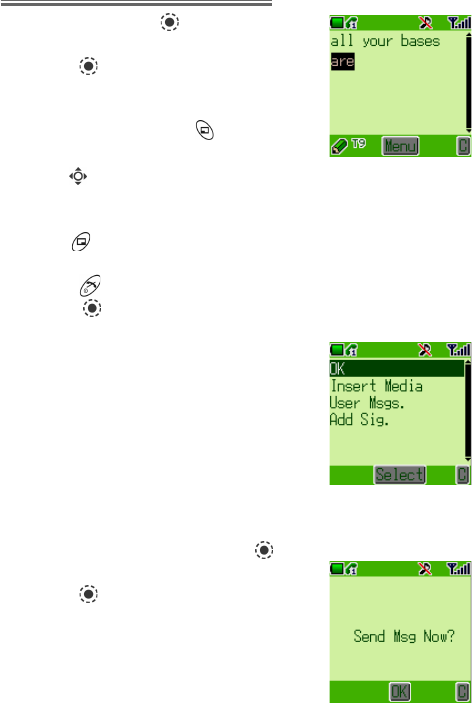
Messages
44
Creating a Text Message
1 From Idle press , select Mes-
sages > Create > SMS/EMS.
Press
2 Write text message. To change text
input method (displayed in lower left
corner of screen), press . See Text
Entry, page 84, for details.
Use to navigate through the mes-
sage and position the cursor to add
text
Use to delete the character to
the left of the cursor
Press to cancel the message
3 Press when you have finished
composing the message
4 The submenu that appears gives the
options of OK / Insert Media /
User Msgs / Add Sig. For informa-
tion on adding attachments, see Text
Message Attachments on the next
page
5 Either browse the Phonebook to se-
lect the number to send the mes-
sage to, or choose OK and enter the
destination phone number. Press
6 You will be asked Send Message Now?
Press
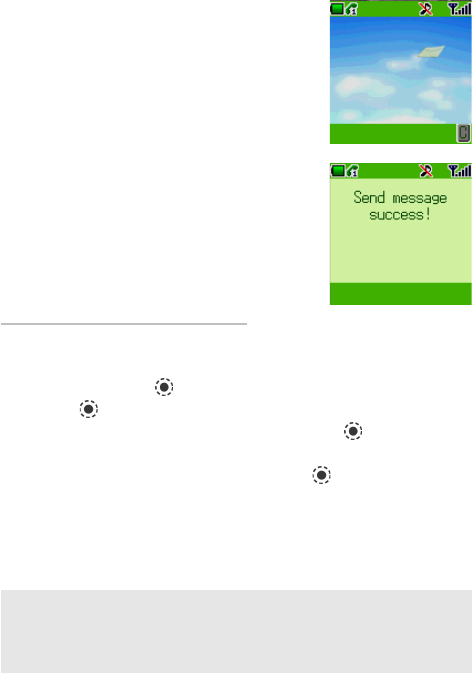
Messages
45
7 As the message is sent the sending
message animation will display.
8 If Delivery Confirmation is enabled
(see previous section) and the mes-
sage is transmitted successfully, Send
Message Success will appear.
Sending Quick Note Messages
Your phone comes with several common message expressions
preinstalled. To send a Quick Note:
1 From Idle press , select Messages > Create > SMS/EMS.
Press
2 Instead of writing the message content, press and select User
Messages. A list of the saved Quick Notes will be displayed.
3 Select the desired Quick Note and press .
4 Enter the phone number and send in the same way as for a stan-
dard text message.
Note: View your Quick Notes at any time by going to My Phone >
Quick Note. You can also use this menu to compose new Quick
Notes.
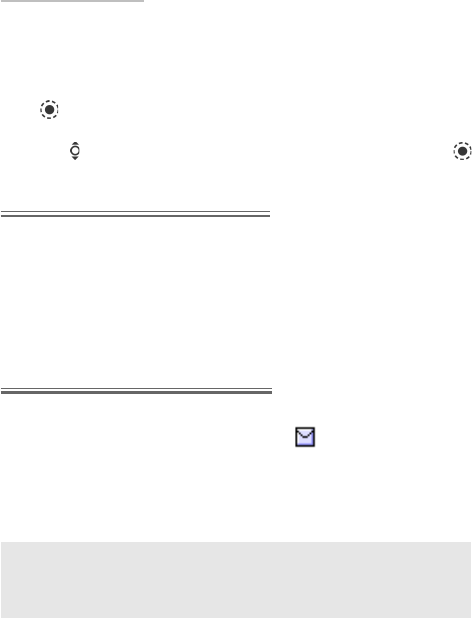
Messages
46
Text Attachments
When creating a text message, it is possible to include attachments
(copyright permitting).
To include an attachment:
1 Follow the instructions above to write the text message then press
. When the OK / Insert Media / User Msgs / Select submenu ap-
pears (see step 4 above), select Insert Media.
2 Use to select the file to be inserted into the text body. Press
Concatenated messages
SMS messages can be made up text and attached pictures or icons to a
maximum size of 160 characters. If you want to send a larger message,
your phone will automatically configure your message as a sting of smaller
messages and send these simultaneously. Concatenated messages such
as this appear to a user as a single message.
Receiving Text Messages
When a Short Text Message is sent to your phone, the message Received
1 New Message and the message indicator ( ) will flash in the display
with an alert signal (this signal - an audible tone or vibration - is set in the
My Phone > Sound Settings menu). This indicates that a new message
has been received.
Note: If the message indicator shows red the message area is full and
you will need to delete old messages in order to be able to receive
new messages in the future.
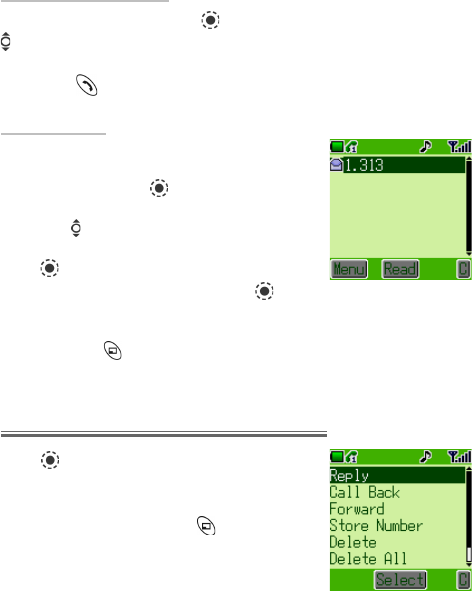
Messages
47
Reading immediately
When Read is displayed press to read the message immediately. Use
to navigate through the message and to identify the sender and the
time the message was sent. With the phone number shown in the Sender
field, press to dial the phone number.
Reading later
Received messages are stored in the
Inbox.
From Idle, press and select Mes-
sages > Inbox
Use to select a message to read
(if there is more than one) and press
to view the message.
You can call the sender, or press
to view your other options (this
submenu can also be viewed by
pressing when the message is
highlighted in the Inbox).
Responding to Text Messages
Press when you have read a message
to view response options. Alternatively,
highlight the message in the Inbox
(Messages > Inbox) and press .Choose
to:
Reply to the message
Call Back
Forward the message
Store the number
Delete the message
Delete All messages or
Extract Media
(if any file is attached to the message)
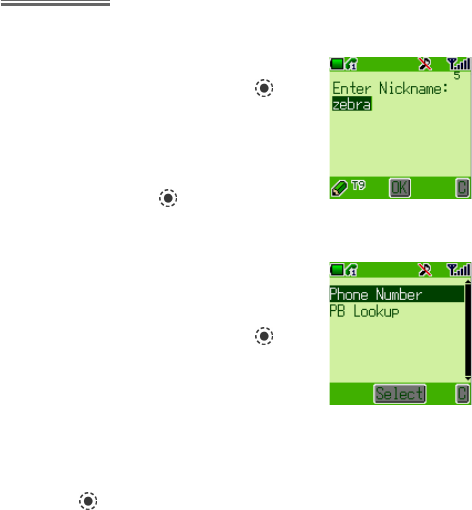
Messages
48
Chat SMS
The Chat feature enables you to read sent and received messages on
one screen when in Chat SMS mode with another party.
1Either: When reading a previously
sent or received message, press
and select Chat and/or enter your
Nickname (up to 18 characters) - see
Text Entry, page 84.
Or: Launch Chat SMS mode from
Idle by pressing and selecting
Messages > Chat SMS > Start
Chat. Enter your Nickname
It is now possible to chat with the other
party, providing they have the chat SMS
facility on their phone. Enter your mes-
sage - see Text Entry, page 64. Press
and enter the destination phone number
if necessary (or browse and select from
Phonebook).
When receiving a message in chat mode, the text will appear automati-
cally above your previous message.
2 Press , select OK to continue the chat
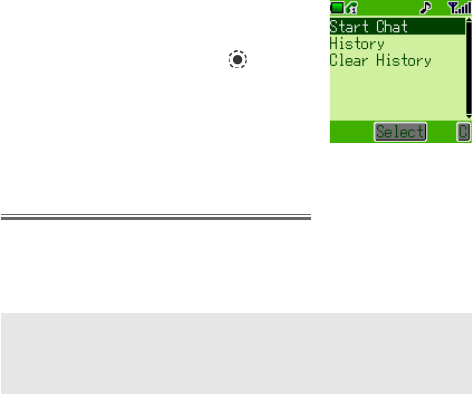
Messages
49
If the phone is not in chat mode when receiving a reply to a chat message,
the reply will be received as a normal SMS. If a voice call is received
when in chat mode, the phone will allow the user to accept the incoming
call and return to chat mode at the end of the call.
Chat conversations are stored and can be
viewed in the History folder.
To open the folder from Idle, press and
select Messages > Chat SMS >
History. Regular Chat users should clear
the history regularly to free memory space.
MMS: Setting Up the Phone
Multimedia Message Service (MMS) Configuration must be performed
before you can send or receive an MMS message. You can create up to
three server profiles on the phone.
Note: Your MMS settings may have been pre-configured by your
service provider. Contact your service provider if you are unclear
how to proceed.
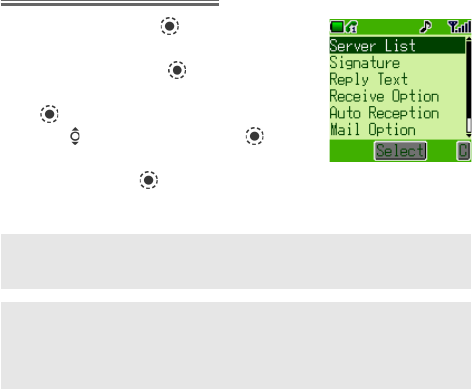
Messages
50
MMS Configuration
1 From Idle press , select Mes-
sages > Options > MMS >
Server List. Press
2 Select the server required and press
3 Use to select Edit and press
4 Select Bearer Type or WAP Set-
ting and press to start configur-
ing settings
Note: Contact your service provider for advice on settings for MMS
configuration.
Note: Use the Messages > Options > MMS menu to configure other
MMS settings. Contact your service provider for details of required
settings.
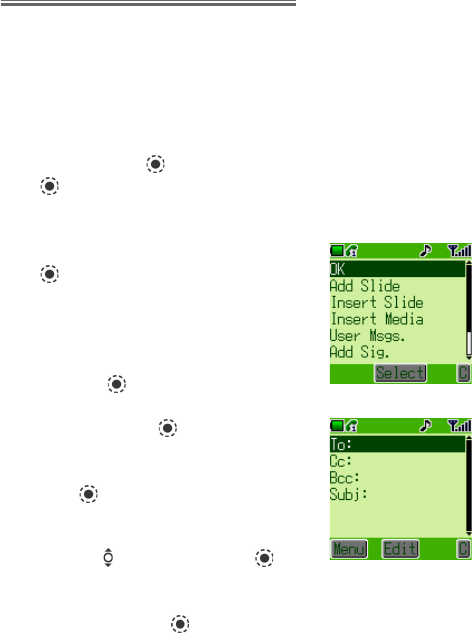
Messages
51
Creating an MMS Message
Your phone supports MMS (Multimedia Messaging Service), which means
you can send digital pictures to an MMS-enabled mobile or to an email
address. Wherever you are, attach a photo, audio message or text, and
send it immediately to your friends.
The following basic steps must be followed for all MMS messages. For
information on multimedia additions, read the following section.
1 From Idle press and select Messages > Create >MMS. Press
2 Compose the text part of the message (see Text Entry, page 84,
for details of entry methods)
3 When the message is complete press
4 To attach a media file, follow the in-
structions on the following page. To
continue without attaching a media
file, select OK from the submenu
and press
5 Select To : , press and enter (or
browse and select) the recipient’s
phone number or email address.
Press to confirm
6 If desired, a message can be delivered
as a copy to another recipient. To do
this, use to select Cc: . Press
and enter (or browse and select) the
copy recipient’s phone number or
email address. Press to confirm
7A Bcc: address or phone number is added in the same way. Bcc
delivery differs from Cc delivery in that the original recipient (whose
address is in the To: field) will not be informed of any copies sent
to Bcc addresses
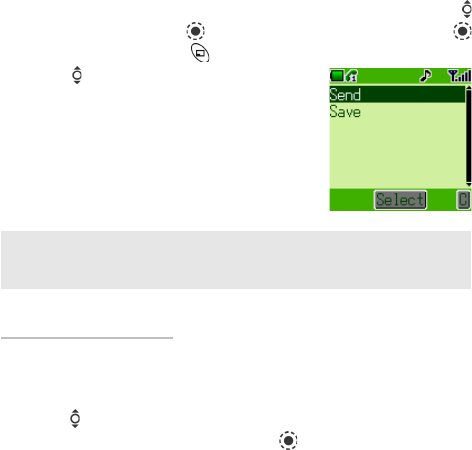
Messages
52
8 When the To : field has been filled and any required Cc or Bcc
entries have been added, add the message subject heading. Use
to select Subj:, press and enter the subject heading. Press
to confirm, then press
9 Use to select Send or Save as
appropriate
Note: Saved messages are stored in the Outbox and can be edited
and sent in the future.
Attaching Media Files
Media files such as voice files can easily be added to MMS messages.
1 Compose a message following steps 1 to 3 on the previous page
2 From the submenu select Insert Media
3 Use to browse and select media files available on your phone
4 When you have selected files, press
5Send or Save the message as instructed on the previous page
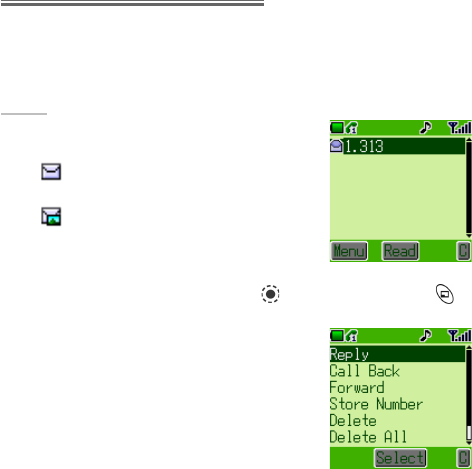
Messages
53
Managing Message Lists
Messages, whether sent or received, are mostly stored in the SIM card
until they are deleted. Selecting a stored message allows it to be read,
replied to, edited or deleted.
Inbox
Messages received are stored in the Inbox
and tagged with icons:
indicates an unread SMS mes-
sage
indicates an unread MMS mes-
sage
From the Inbox, select a message. Press to read the message or to
view other options:
Reply to the message
Call Back the sender
Forward the message
Store the sender’s number
Delete the message
Delete All messages from the Inbox
Extract Media files from the mes-
sage
Edit the message content before
forwarding or saving
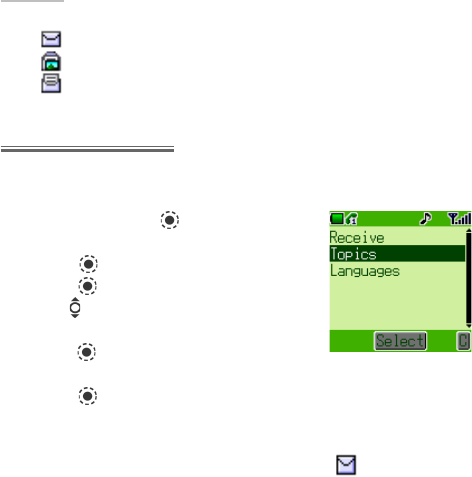
Messages
54
Outbox
Messages sent or edited are stored in the Outbox and tagged with icons:
indicates an unsent SMS message
indicates an unsent MMS message
indicates an unsent EMS message
Cell Broadcasts
You need to specify the topic(s) of information you wish to receive as
broadcasts before they can be received.
1 From Idle press , select Mes-
sages > Broadcasts > Topics and
press
2 Press twice to insert a new topic
3 Use to cycle through the available
topics
4 Press and select RX On from the
pop up menu
5 Press to insert the currently dis-
played topic into your broadcast list
When a low priority broadcast has been received, will be displayed
on the Idle screen. If a high priority broadcast is received, its text con-
tent will be displayed on the idle screen
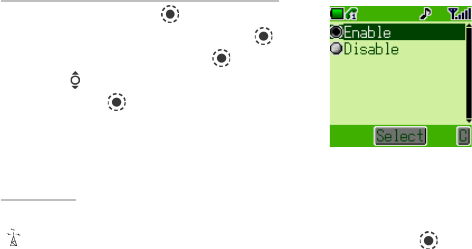
Messages
55
Enabling/Disabling Cell Broadcasts
1 From Idle press , select Mes-
sages > Broadcasts and press
2 Select Receive and press
3 Use to select Enable or Disable
and press
Language
The language in which broadcast messages are displayed can be changed
(). Go to Messages > Broadcasts > Languages and press
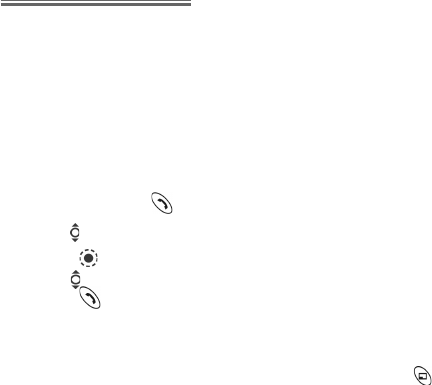
Call Information
56
Call Information
This section explains how you can obtain more information about your
calls, including:
DRecent calls made, received and missed
DCall duration
DCall charges
Recent Numbers
Recently dialled phone numbers are stored in Last Dial.
If Caller Identification is available, the caller’s phone number for an an-
swered call will be stored in the Answered Call menu and an unan-
swered call will be stored in the Unanswered Call menu.
If Caller Identification is not available then calls will still be stored but will
have the date and time attributed to them.
When the store is full the next phone number will overwrite the oldest.
1 From Idle press
2 Use to select Last Dial, Answered Call or Unanswered Call.
Press
3 Use to select the phone number (or name) you wish to redial.
Press
You can edit or delete the phone number before dialling – see Editing
Phonebook Entries, page 18.
If you wish to store the selected number in Phonebook, press while
the number is displayed – see Storing a Number in the SIM /Mobile
Phonebook, pages 15-16.
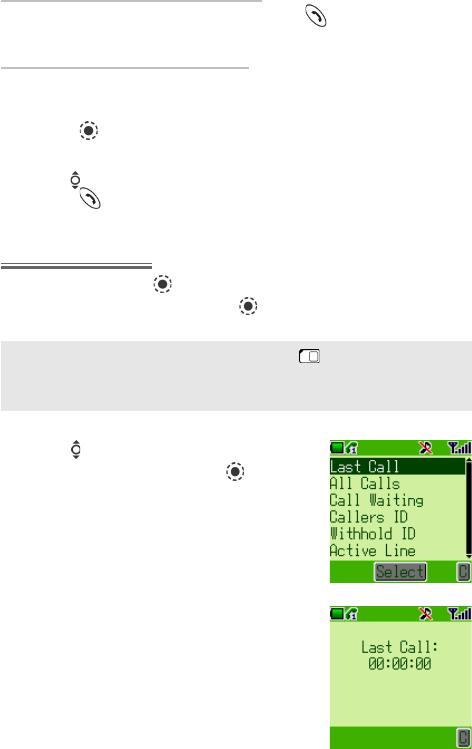
Call Information
57
Calling the Last Dialled Number
To redial your last called phone number press twice.
Returning an Unanswered Call
When the display shows that you have received calls but not answered
them.
1 Press
The last caller’s phone number will be displayed if it is available.
2 Use to select the phone number you wish to dial
3 Press
Call Duration
1 From Idle press , select (Applications >) Phone Option >
Call Services > Calls. Press
Note: The Calls feature is SIM dependent ( ). If the SIM does not
support this function then items under Calls menu will be found di-
rectly under the Call Services menu.
2 Use to select one of the features
described below, and press
Last Call displays the duration and call
charge (if available) of the last call made.
Times are indicated as: hours (0-99), min-
utes (0-59), seconds (0-59) - HH:MM:SS.
All Calls displays the accumulated dura-
tion and call charge (if available) of Incom-
ing and Outgoing calls. The lock code or
PIN2 is required to reset the timer and
call charge meter.
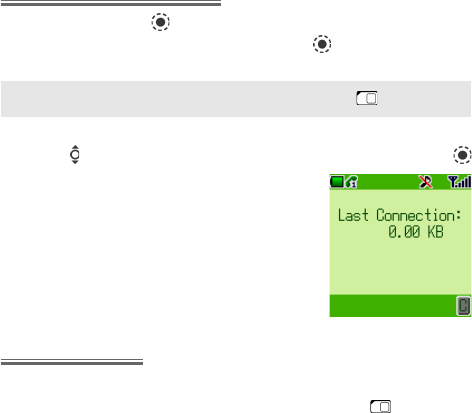
Call Information
58
GPRS Call Duration
1 From Idle press and select (Applications >) Phone Option
> Call Services > Connections. Press
Note: The Connections function is SIM dependent ( ).
2 Use to select one of the features described below, and press
Last Connection displays the amount of
data transferred during the last call.
All Connections displays the accumulated
duration and amount of data transfer. The
lock code or PIN2 is required to reset the
timer.
Call Charges
To maintain control over the cost of calls that are made, the phone can
be set to restrict use to a finite number of units overall ().
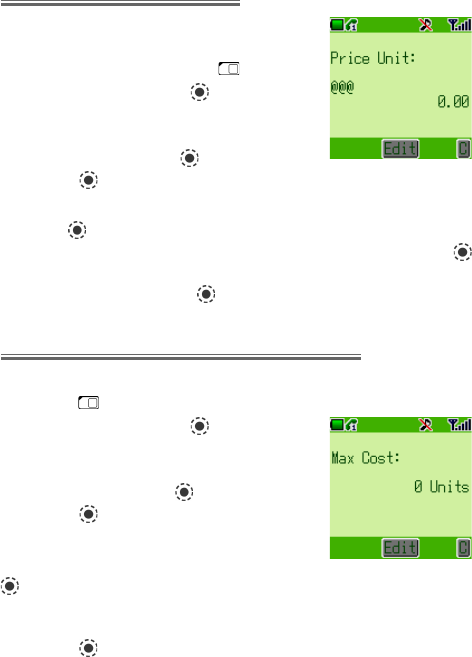
Call Information
59
Setting the Unit Price
Firstly, a price per unit must be entered.
This is the cost that the Service Provider
charges for one unit of call time ().
1 From Idle press , select
(Applications >) Phone Option >
Call Services > Service Charges
> Price Unit. Press
2 Press to edit the values
At this point you will be asked to enter your PIN2 or Lock code. Do so
and press .
3 Enter a currency unit (up to three characters) e.g. GBP. Press
twice
4 Enter a price and press twice
Setting the Maximum Unit Level
This function allows the user to pre-determine the maximum cost of
calls made ().
1 From Idle press , select
(Applications >) Phone Option >
Call Services > Service Charges
> Max Cost. Press
2 Press twice to edit the values
At this point you will be asked to enter
your PIN2 or lock code. Do so and press
3 Enter a value (number of units) which is to be the maximum
permitted, and the corresponding cost will be displayed
4 Press twice to accept
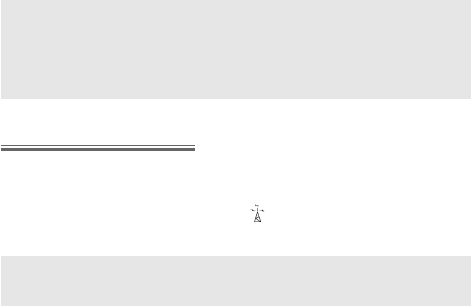
Call Information
60
Note: The duration of one unit may vary during the day, peak and
off-peak times. Therefore, the call charge can be calculated
accordingly. However, call charge information may not give an accu-
rate reflection of the tariffs charged by your Service Provider.
Call Identification
In the Call Services > Calls menu, the Caller’s ID and Withhold ID func-
tions allow you to check the status of whether a Caller’s Identification is
sent or can be received (Withhold ID ).
Note: When checking the status the phone must be registered with a
network.
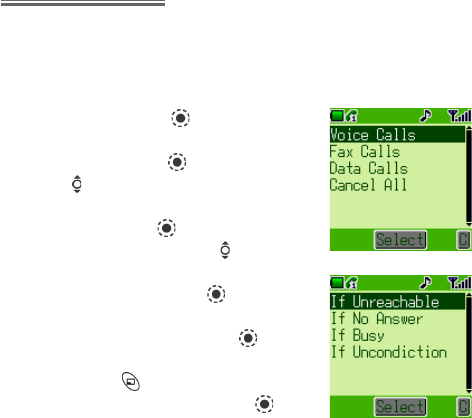
Advanced Operation
61
Advanced Operation
This section contains detailed information on call management including:
DCall diversion
DCall holding
DCall waiting
DMaking and receiving a second call
DTransferring calls
DMulti-party calls
DChanging network
Diverting Calls
Voice, fax and data calls can be diverted according to different conditions
and to different numbers. For example you may wish voice calls to be
diverted to Voicemail when the phone is switched off. To enable call
diversion:
1 From Idle press and select
(Applications >) Phone Option >
Call Divert. Press
2 Use to select the type of call to
divert (you can repeat this step as
necessary). Press
3 If diverting voice calls, use to se-
lect circumstances in which to ini-
tiate the diversion. Press
4 Enable the diversion by selecting On
from the Status menu. Press
5 Enter the phone number to divert
to (or press and select the num-
ber from your Phonebook). Press
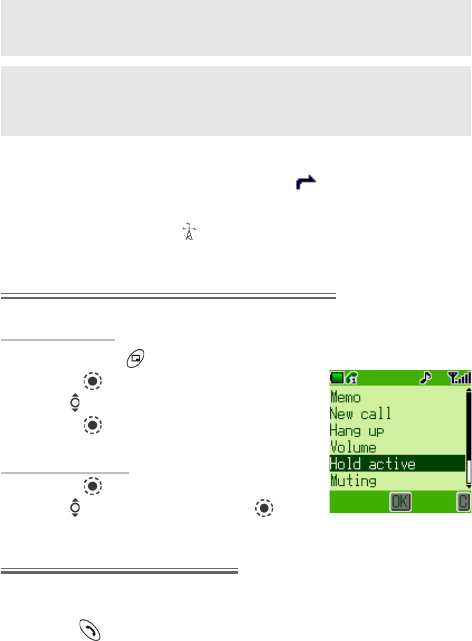
Advanced Operation
62
Note: To edit a call diversion setting, follow the steps above and
reset according to the new settings.
Note:To cancel a diversion setting, select Off in step 4 above. To
cancel all diversion settings, go to (Applications >) Phone Option
> Call Divert > Cancel All.
When a diversion is enabled the divert icon ( ) is displayed.
When updating or checking the status of Call Divert the phone must be
registered with a network ( ).
Holding Calls and Call Waiting
Holding a Call
During a call press . Alternatively:
1 Press
2 Use to select Hold Active.
Press
Resuming a Call
1 Press
2 Use to select Resume . Press
Making a Second Call
1 During an ongoing call, enter phone number (or recall from
Phonebooks – see Browsing the Phonebooks)
2 Press
The first call will be placed on hold.
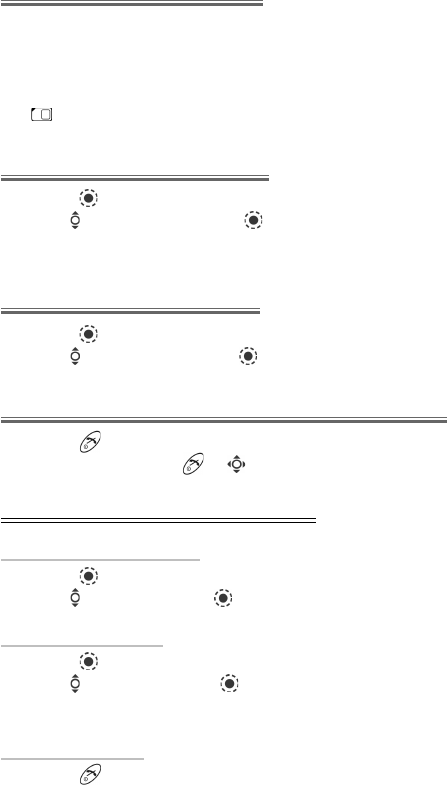
Advanced Operation
63
Receiving a Second Call
A second call can be received, if Call Waiting is switched on. This is en-
abled from the (Applications >) Phone Option > Call Services >
Calls menu. It is not possible to have more than one fax or data call. All
voice calls must be ended before you can make or receive a fax or data
call ( ).
Accepting a Second Call
1 Press when the second call is received
2 Use to select Accept. Press
The current call will be placed on hold.
Rejecting a Second Call
1 Press when the second call is received
2 Use to select Reject. Press
Ending Current Call to Receive Another
1 Press when the second call is received to end the current call
2 Press any key except or to receive the new call
Operation During Two Calls
Swapping Between Calls
1 Press
2 Use select Swap. Press
Ending Current Call
1 Press
2 Use to select End. Press
The held call will remain held.
Ending Both Calls
Press
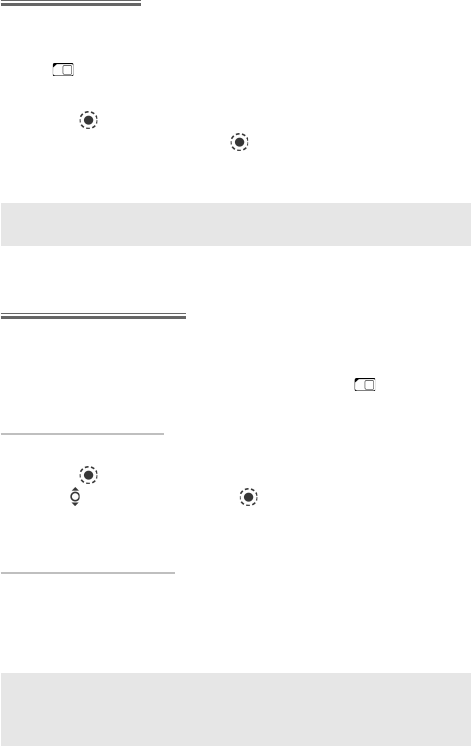
Advanced Operation
64
Call Transfer
With two calls connected, Call Transfer enables the user to connect them
together ending your connection, leaving the other parties to talk to-
gether ( ).
When two calls are connected to your phone:
1 Press
2 Use e to select Trans. Press
The two calls will be connected to each other and your call will be ended.
Note: Two call transfer cannot be activated while in Multi-party mode.
Multi-party Calls
A Multi-party call enables three to five people to be in conversation at
the same time. It is possible to swap between a Multi-party call and an-
other call in the same way as with two separate calls ( ).
Enabling Multi-party
With two calls connected (one active, one on hold):
1 Press
2 Use to select Merge. Press
All three parties should now be able to talk to each other.
Adding to Multi-party
It is possible to add parties to the Multi-party call (up to a maximum of
five) either by making a call or accepting an incoming call. The call can
then be merged into the Multi-party.
Note: When making a call or accepting an incoming call the Multi-
party call will be placed on hold. The callers in the Multi-party call can
continue to communicate with each other while on hold.
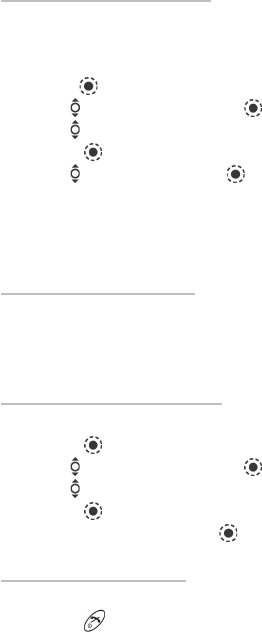
Advanced Operation
65
Splitting a Multi-party Call
The user can select an individual from the Multi-party and remove their
connection. This enables you to talk privately without the participation
of the rest of the Multi-party.
1 Press during a Multi-party call
2 Use to select Option. Press
3 Use to select a caller in the Multi-party
4 Press
5 Use to select Split. Press
The selected caller will be split from the Multi-party call and the Multi-
party call will be placed on hold (the remaining Multi-party callers can
still communicate).
Ending Multi-party Calls
The user can either select an individual in the Multi-party and end the call
or end the entire Multi-party call. If a call is held, or an other call is in-
coming then an individual call cannot be ended.
Ending a Single Connection
During a Multi-party call:
1 Press
2 Use to select Option. Press
3 Use to select a caller in the Multi-party
4 Press
5 Use e to select End. Press
Ending all Connections
During a Multi-party call:
Press to end all the calls at once
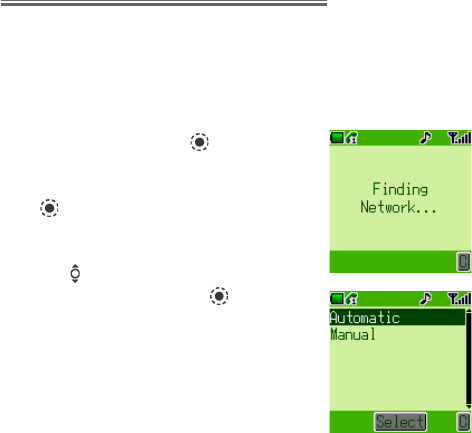
Advanced Operation
66
Changing to a New Network
When not in your home country / region, the user may use a network
that is not directly subscribed to. This is called ROAMING. Legal restric-
tions may not permit roaming in your home region.
The New Network function is used to manually select a network that is
available in your current location.
1 From Idle press , select
(Applications >) Phone Option >
Network > New Network. Press
2 Your phone will search for available
networks
3 Use to select one from the list of
available networks. Press
If you cannot register with the selected
network, that network will be greyed out.
When the Search Mode is set to Auto-
matic the phone will automatically reselect
a new network in order to maintain opti-
mum network availability. With the
Search Mode set to Manual the phone
will only use a selected network. If cover-
age is lost another network should be
selected.
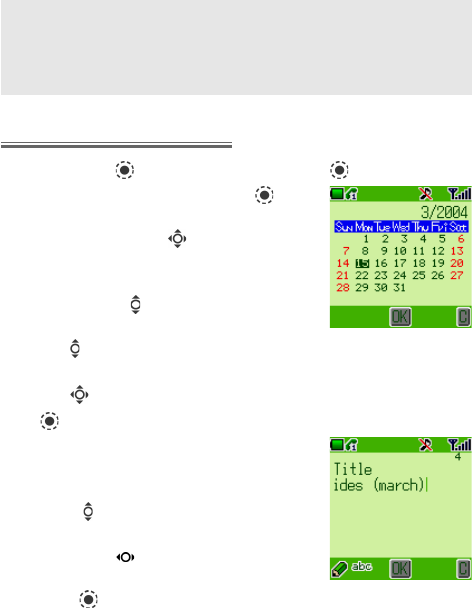
Schedule
67
Schedule
The Scheduler can be used to register reminders for personal events as
well as planning holiday periods.
Caution: Ensure that any settings made in the Scheduler will not con-
travene any regulations whereby the phone may automatically power
on when in an aircraft or medical facility etc. - see Important Infor
mation, page i.
Creating a Reminder
From Idle, press , select Scheduler and press again.
1 Select [New Event] and press
to create a new schedule event. Use
the Navigation key ( ) to select the
date for your reminder.
2 First move the cursor to the year
entry and use to adjust the entry if
necessary.
4 Use in the same way to adjust the
month entry.
5 Use to place the cursor over the appropriate date entry. Press
to select the date
6 Enter the time for the reminder. Use
the numbered keys to enter the cor-
rect time (using the 24-hour clock)
or use to adjust the time displayed.
Move between the hour and minute
fields using
7 When the time is entered correctly,
press to confirm
8 Enter a name to identify this sched-
ule entry

Schedule
68
Viewing & Editing Reminders
Open the Scheduler menu. All scheduled reminders are listed. Use to
highlight the reminder you wish to view and press . The time, data and
name of the reminder will be displayed. Press to edit the details.
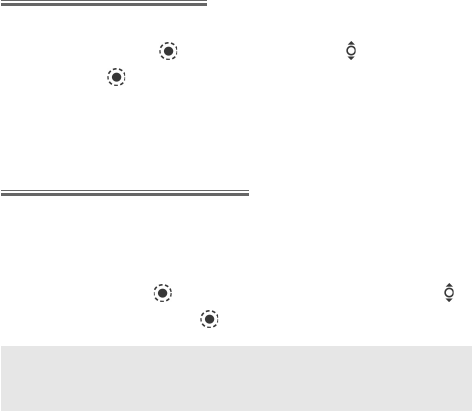
Games
69
Games
Embedded Games
To enter the embedded games menu:
From Idle, press and select Games. Use to select a game
and press to launch.
Follow the prompts in the pop up menu for playing instructions and game
options
Downloadable Games
The downloadable games menu enables you to use one factory embed-
ded game and download another game from the games catalogue.
To enter the Downloadable games menu:
From Idle, press and select Applications > Games. Use to
select a game and press to launch.
Note: A downloaded game will overwrite the previously downloaded
game.
Follow the on-screen instructions to play the game.
The game catalogue is renewed regularly and updates automatically when
a game is downloaded.
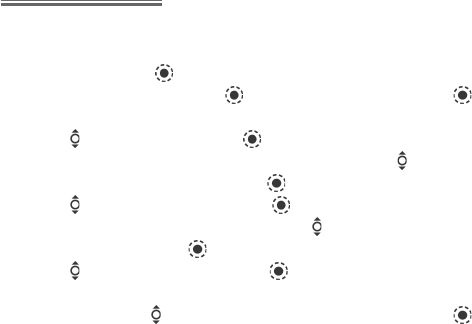
Games
70
Game Settings
Use the Applications > Games menu to set your game nickname and
set sound, backlight and vibration levels for gameplay.
1 From Idle, press , select Applications > Games > Setting
2 To enter a Nickname press . Enter the name and then press
to confirm
3 Use to select Sound. Press
4 Sound can be set to Off, Low, Medium or High. Use to select
the desired setting and then press to confirm
5 Use to select Vibrations. Press
6 Vibration can be set to Off or On. Use to select the desired
setting and then press to confirm
7 Use to select Back light. Press
8 The back light can be set to Off, On 30s (on for 30 seconds) or
Always on. Use to select the desired setting and then press
to confirm
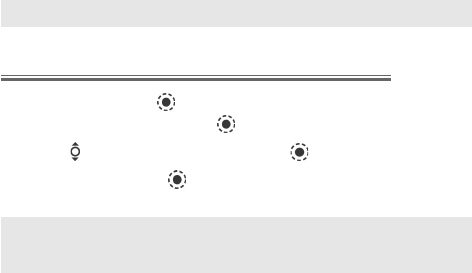
Managing Multimedia Files
71
Managing Multimedia Files
The multimedia files saved in G60U are located in the Media Folder (My
Phone > Media Folder). There are four predefined folders (Picture,
Animation, Melody and Memory Status).
Note: Changing SIM does not affect the contents of stored data.
Displaying Pictures and Animations
1 From Idle, press , select My Phone > Media Folder > Pic-
tures / Animation. Press
2 Use to select a file to display. Press
3 Select View. Press
Note: The phone cannot display a file that is not in one of the sup-
ported formats.
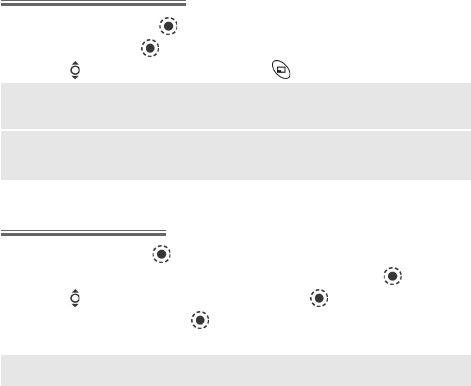
Managing Multimedia Files
72
Playing Melodies
1 From Idle, press and select My Phone > Media Folder >
Melody. Press
2 Use to select a file to play. Press to view
Note: You can compose your own melodies and ringtones. Turn to
Composing a Melody in Personalising Your Phone for full instructions.
Note: You cannot edit polyphonic ring tones, music files or files that
cannot be forwarded or saved.
Renaming Files
1 From Idle, press , select My Phone > Media Folder and open
the subfolder for the file you wish to rename. Press
2 Use to select the file to rename. Press
3 Select Rename. Press
Note: Do not use special characters in the new name.
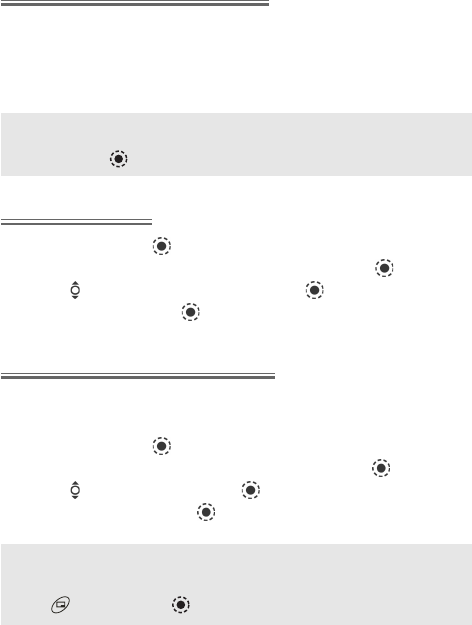
Managing Multimedia Files
73
Creating Mail from Files
You can jump in one step from a file to the create mail screen with the
file as an attachment.
The phone will display the ‘Create Mail’ screen.
Note: You cannot copy a file that cannot be forwarded or saved;
You can press to select Create Mail while the file is displayed.
Deleting Files
1 From Idle, press , select My Phone > Media Folder and open
the subfolder for the file you wish to delete. Press
2 Use to select the file to delete. Press
3 Select Delete. Press
Checking File Properties
You can view the file name, date, file size, whether the file can be for-
warded and whether it can be saved.
1 From Idle, press , select My Phone > Media Folder and open
the subfolder for the file you wish to check. Press
2 Use to select the file. Press
3 Select Property. Press
Note: If there is not enough memory capacity in the folder when you
try to save a file, the phone will display Folder is Full. Delete Data?
Press to keep file or to delete file.

Managing Multimedia Files
74
Checking Folder Properties
To check the status of the Media Folder, from Idle, press , select My
Phone > Media Folder > Memory Status. Press . A graphic dis-
play of free space in the folder will be displayed.
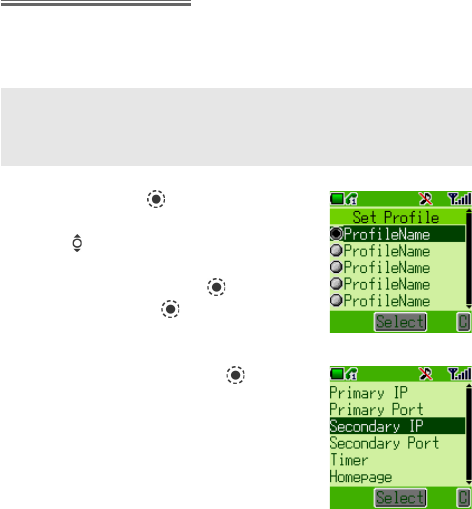
WAP Browser
75
WAP Browser
Your phone’s WAP (Wireless Application Protocol) Browser enables the
user to access Internet services supported by the network, such as news,
weather reports and sport.
Browser Settings
Before Internet services can be accessed, the SIM must be data enabled
and the relevant configuration information, entered into the phone.
Note: The configuration information may have been pre-programmed
by your service provider. Modifying these settings may cause failure
of the Browser.
1 From Idle press , select Browser
> Browser Setting > Set Profile.
Use to select a browser profile
(you can configure up to five
browser profiles). Press
2 Select Edit. Press
3 Select WAP Setting. Press
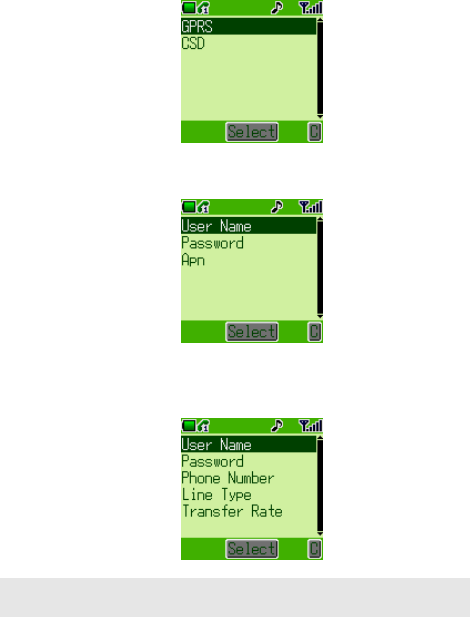
WAP Browser
76
A list of configuration parameters will be displayed. Select each param-
eter in turn and enter the appropriate values (contact your service pro-
vider for details if necessary).
For each browser profile, set also the Bearer Type. Go to Browser >
Browser Setting > Set Profile > [Select Profile] > Edit > Bearer
Type.
To configure a GPRS browser, enter User Name, Password and Apn
(Access Point Name).
To configure a CSD browser, enter User Name, Password, Phone
Number, Line Type and Transfer Rate.
Note: Contact your service provider for setup values if you are unsure.
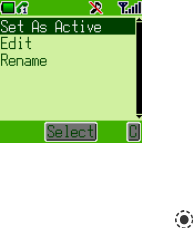
WAP Browser
77
Record your WAP settings in the table at the rear of this booklet for easy
reference.
When you have entered settings for a browser profile, you may wish to
rename the profile to make it easier to remember. To rename a profile,
go to Browser > Browser Setting > Set Profile > [Select Profile]
> Rename. The current profile name will be displayed. Edit this name
to rename the profile.
Since you can set up to five profiles, you should also select which is your
active profile. To do so, go to Browser > Browser Setting > Set
Profile > [Select Profile] > Set As Active. Press
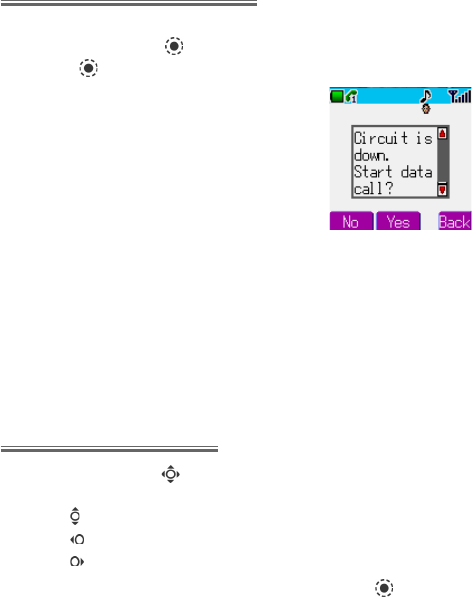
WAP Browser
78
Activating the Browser
To activate the Browser, either:
From Idle, press and select Browser > Start Browser.
Press
The first time that the browser is activated
there will be no content. Each time the
browser is activated, the last page viewed
from the previous WAP session will be
recalled. At the start of a WAP session, the
browser content may be retrieved from
the cache (cache is the phone’s memory
that stores content downloaded in the
past). At this stage the user will remain off
line. When data is required from the WAP
server, the user will be prompted to Start
data call?
If Yes is selected, the phone will go on line and the browser will go to the
home page.
Navigating Content
Use the Navigation key ( ) to scroll through the content on the screen
as follows:
Use to scroll up/down on the current page
Use to return to the previous object/page
Use to return to the next selectable object/page
When linked text (underlined text) is highlighted, press to load the
page represented by the link.
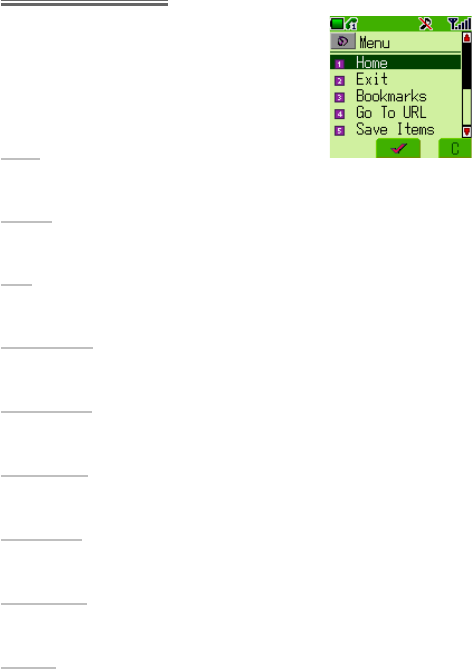
WAP Browser
79
Browser Menu
The Browser contains its own menu which
is applicable when content is currently
being displayed (either on-line or off-line).
This menu is used as follows:
Back
Returns the user to the Browser Start Up menu
Home
Displays the Home URL content as defined by the network operator
Exit
Deactivates the Browser
Bookmarks
Use, view, add and delete bookmarks
Go To URL
Enter URL to open
Save Items
To save images or other items from the current page
Snapshots
Take a snapshot of the current page
Show URL
Display the current URL
Reload
Reload and update the current page

WAP Browser
80
Homepage URL
Download parameters (enable or
disable the downloading of multime-
dia files)
Restart Browser
Security submenu
About
Provides information about the type of browser and security options
Settings
Allows the user to select and set:
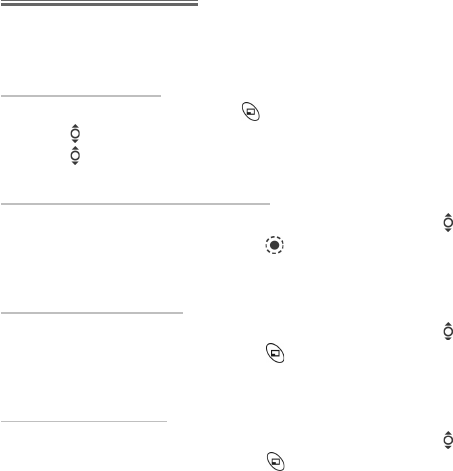
WAP Browser
81
Using Bookmarks
Frequently accessed pages may be bookmarked to save time - you won’t
have to enter the URL each time you want to visit the page.
Adding a Bookmark
1 While viewing the page, press
2 Use to select Bookmark
3 Use to select either Title or URL as the Bookmark name
Recalling Pages Using Bookmarks
Select Bookmarks from the Browser menu. Select View and use to
highlight the bookmark you want. Press .
Renaming a Bookmark
Select Bookmarks from the Browser menu. Select View and use to
highlight the bookmark you want. Press and select Edit.
Deleting Bookmarks
Select Bookmarks from the Browser menu. Select View and use to
highlight the bookmark you want. Press and select Delete.

WAP Browser
82
Deactivating the Browser
The Browser can be deactivated as follows:
When browsing on-line, press to review cache off line.
When browsing off-line, press to return to Idle mode.
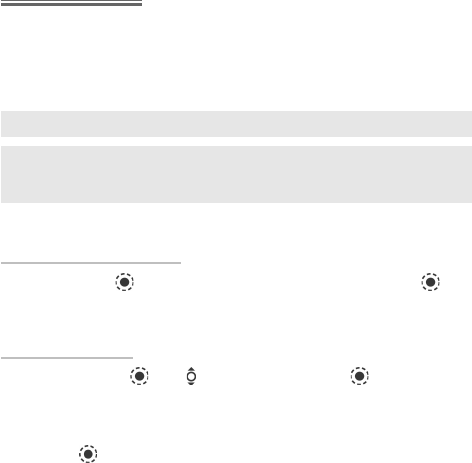
Additional Features
83
Additional Features
Voice Memo
You can record a two-way conversation during a call and use the phone
as a dictaphone. The maximum length of a recording is 16 seconds. Old
recordings are overwritten; only one recording can be stored.
Note: If a different SIM is installed any voice memos will be lost.
Caution: Security of a recorded message is your responsibility. You
MUST ask for the other party’s consent before recording.
Record a Voice Memo
From Idle, press and select Applications > Record. Press
The recording will stop automatically after 16 seconds.
Recording a Call
During a call, press . Use to select Memo Press .
A tone will sound when recording starts. When the recording stops a
tone will sound.
If you press while recording a call, recording will stop but no tone will
sound to either party.
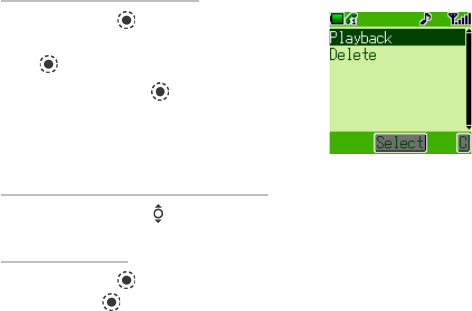
Additional Features
84
Play Back a Voice Memo
From Idle, press and select Applica-
tions > Voice Memo Play > Playback.
Press .
To stop playing, press .
Volume Control During Playback
While playing back use to adjust the volume of the voice memo.
Delete a Memo
From Idle, press and select Applications > Voice Memo Play >
Delete. Press .
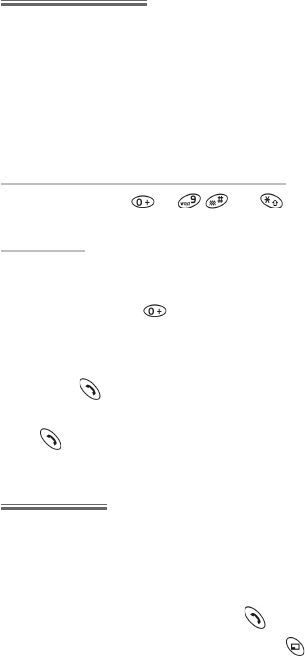
Additional Features
85
DTMF Tones
Dual Tone Multi-Frequency Tones (DTMF) tones can be sent during
conversation. These are often used to access voice mail, paging and com-
puterised home banking services. For example, you may need to input a
number to remotely access voice mail messages. A phone number may
be stored in the Phonebook with DTMF tones, allowing the number to
be dialled upon recall and the DTMF number to be sent automatically.
Sending DTMF Tones During a Call
Simply enter digits ( to , and ) during the call.
Pause Dial
Pause Dialling allows you to send DTMF tones automatically.
1 Enter phone number
2 Press and hold until a p is displayed at the end of the phone
number entered
3 Enter DTMF digits after the pause, e.g. enter the number to ac-
cess voice mail messages.
4 Press
When the call is successful DTMF tones will be sent after 3 seconds or
press to send the DTMF tones manually.
Note Pad
During a call numbers can be entered which you may wish to dial when
the call has ended.
During a call:
1 Enter phone number
2 When the call has ended press to call that number
To store the number in Phonebook, press while the number is dis-
played – see the instruction on storing numbers in the section Phonebook.
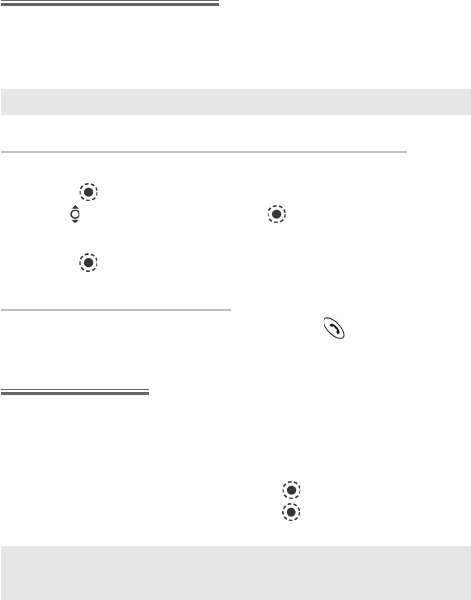
Additional Features
86
Desktop Handsfree
Desktop Handsfree enables you to hold a conversation without having
to hold the phone to your ear.
Note: Do NOT hold the phone to your ear in Handsfree mode.
Swapping Between Handsfree and Handheld Calls
During a Handheld call:
1 Press
2 Use to select Handsfree. Press
During a Handsfree call:
Press twice to revert for Handheld operation
Answering a Call Handsfree:
To answer a call using Handsfree, press and hold .
Auto Answer
When Auto Answer is switched on, and Personal Handsfree or a head
set or car kit is connected, a call will be answered without pressing any
keys. Any call waiting should be answered in the normal way.
To enable Auto Answer, from Idle, press and select My Phone >
Auto Answer. Choose Enable and press .
Note: Take care when Auto Answer is selected to ensure unauthorised
listeners cannot overhear your phone conversations.
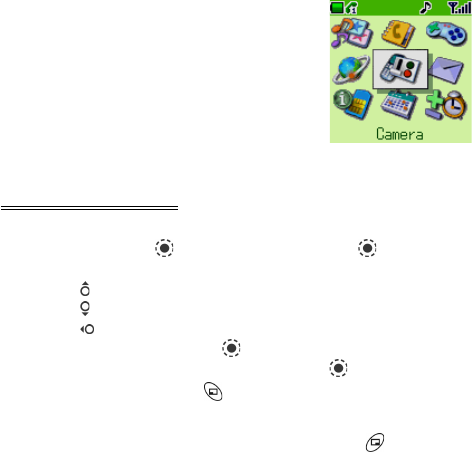
Camera Accessory
87
Camera AccessoryCamera Accessory
With the Panasonic camera accessory attached to your phone, you can
take photos then save them or send them immediately in a MMS message.
The camera accessory slots onto the accessory connector on the base of
your phone.
When the camera accessory is plugged in,
the main menu changes. The Key Guard
icon is replaced by a Camera icon as
shown. Select Camera for all related
functions.
Taking a picture
To take a picture, first ensure the camera accessory is plugged in. Then:
1 From Idle, press and select Camera. Press
2 Position the camera to frame the desired photo
Use to zoom in,
to zoom out and
to turn on the photo light
When you are ready, press to capture the photo
3 The captured photo will be displayed. Press to store the photo
in your Media Folder or to immediately attach the photo to a
new MMS message ready for sending (see Messaging for details of
how to compose and send MMS messages). Press to delete the
photo instead.
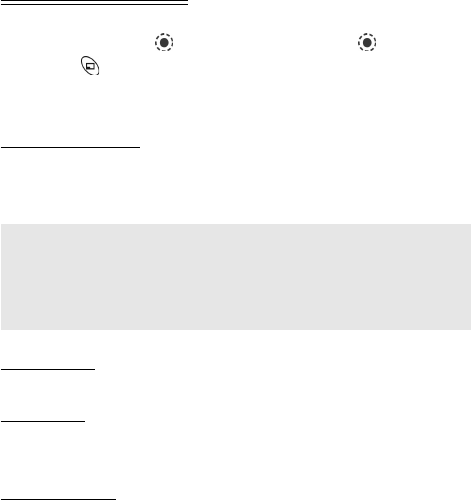
Camera Accessory
88
Camera Options
To take a picture, first ensure the camera accessory is plugged in. Then:
1 From Idle, press and select Camera. Press
2 Press to open the Options menu. Select from the following
options:
Photo Resolution
Choose from VGA (640±±
±±
±480), QVGA (320±±
±±
±240), QQVGA
(160±±
±±
±120) or Screen Size (128±±
±±
±96).
Note: Higher resolution pictures are of better quality but occupy a
larger share of your phone’s memory. If you want to take several high
resolution pictures, consider reducing the amount of memory taken up
by other types of media file such as ring tones and downloaded games.
Photo Light
Turn the built-in photo light On or Off.
Self Timer
Turn the Self Timer On or Off. When the Self Timer is turned on, there
is a delay after the capture button is pressed before the photo is taken.
Shutter Sound
Select from three available shutter sounds.
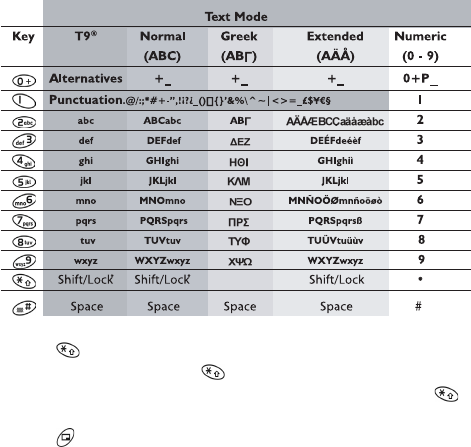
Text Entry
89
*Press once to enter a single capital letter (subsequent characters
will be lower case). Pressing twice acts as a keyboard CAPS LOCK
function and subsequent characters will be uppercase. Press a
third time to return to lowercase character entry.
Press to return to the message screen.
Text Entry
The phone provides a means for entering alphanumeric characters to
enter details into the Phonebook, to create text etc. This section details
the characters that can be entered and the relevant keys to press.
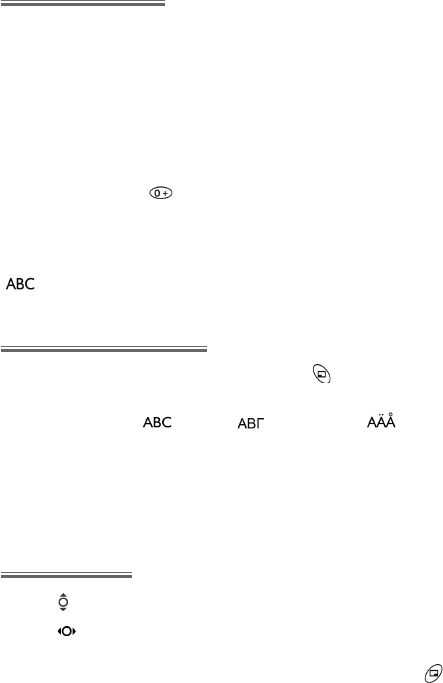
Text Entry
90
T9® Text Input
Using this mode of text entry dramatically reduces the number of key
presses required:
Press a key once for any letter you require on that key. The desired
letter may not be displayed. Continue pressing other keys until the end
of a word is reached; then check that the word has been typed correctly
before continuing on to the next word.
If the combination of letters typed has produced a word which is not the
one you require, press repeatedly until the correct word is displayed.
Continue to the next word.
If the word you require is not in the internal dictionary (i.e. it is a proper
noun or a rarely used word) then it should be entered using the Normal
() mode.
Other Text Modes
To access any of the other text entry modes use to cycle through until
the desired mode is displayed in the left side of the display.
When using Normal ( ), Greek ( ) or Extended ( ) text entry
modes, each time a key is pressed in quick succession it will display the
next character available on that key. Releasing the key, or pressing an-
other key will enter the currently displayed character and the cursor will
move to the next position.
Editing Text
Pressing will move you up or down one text line.
Pressing will move you left or right one character. When the cursor is
moved over a character and another key pressed this will insert the new
character immediately before the selected character. Pressing will
delete the character to the left of the cursor or delete the current line
when pressed and held.

Trouble Shooting
91
Trouble Shooting
Should any problem persist contact your dealer.
Problem
Phone will not
switch on
Extremely short
battery life for a
new battery
Short battery life
for an old battery
The charging
indicator does not
light, the battery
level indicator does
not appear and the
phone cannot be
switched on when
charging
Battery fails to
charge
Cause
The network you are
using and the condition
of the battery can affect
battery life
The battery has worn
out
The battery is not
attached to the phone
or when the battery has
been deeply discharged
the phone will take a
short time until the
indicator lights
The battery is not
attached to the phone
Battery has been
connected to the phone
after the Fast Travel
Charger has been
switched on
Remedy
Check that the battery is
fully charged and correctly
connected to the phone
Replace with a new fully
charged battery
Leave the phone charging
the battery for a few
minutes before the
indicator is lit and
attempting to switch it on
Ensure the battery is
fitted to the phone prior
to commencing charging.

Trouble Shooting
92
Calls cannot be
made
Calls cannot be
made from Fixed
Dial Store
Calls cannot be
received
Emergency calls
cannot be made
Phone numbers
cannot be recalled
from Phonebook
The phone is
locked
Outgoing calls are
barred
The phone is not
registered to a
network
The phone is not
switched on
Incoming calls are
barred
The phone is not
registered to a
network
You are not in a
GSM coverage
area
The phone is
locked
Phone number has
been restricted
Unlock the phone
Disable the outgoing call
barring, or barred dial
Move to a coverage area
and operate your phone
after it has registered with
a network.
Check your SIM supports
Fixed Dial
Check if the Fixed Dial is
switched on
Check the phone number
is stored in the Fixed Dial
Switch the phone on
Disable the incoming call
barring
Move to a coverage area
and operate your phone
after it has registered with
a network.
Check that the antenna
symbol S is displayed -
move to a coverage area
and operate your phone
when the antenna symbol
is displayed
Unlock the phone
Switch off restriction

Trouble Shooting
93
Important Error Messages
These are some of the most important error messages which may be
displayed:
Area Not
Allowed
Network Not
Allowed
Security Failure
SIM Blocked /
Contact Service
provider
SIM Error
SIM Invalid
Function
Unavailable
PIN2 Invalidated
Message
Rejected Store
Full
Phone Number
Too Long
(Max:20)
Warning Store
Full Continue ?
Roaming in the selected area is not allowed
Roaming with the selected network is not allowed
The network has detected an authentication failure
because your SIM is not registered with that network
- contact your Service Provider
The SIM is blocked because one of the PIN/PIN2
unblocking keys (PUK/PUK2) has been entered
incorrectly ten times - contact your Service Provider
The phone has detected a problem with the SIM -
switch the phone off and then back on; if the message
is still displayed contact your Service Provider
The SIM has failed one or more of the SIM
personalisation checks - contact your Service
Provider
The selected feature is either not supported by the
SIM or is not available with the current subscription -
contact your Service Provider
The PIN2 is blocked permanently because the wrong
PUK2 has been entered ten times, services controlled
by PIN2 cannot be used - contact your Service
Provider
A message has been received but the message store
is full - to receive messages, delete some of the
currently stored messages or set messages to Auto
Delete
The edited or newly created Phonebook number is
too long for the SIM
The message area is full. Your messages cannot be
stored until some of the currently stored messages
are deleted

Trouble Shooting
94
Verification
Failure
Incorrect Lock
Code
Incorrect PIN /
PIN2 / PUK /
PUK2
Auto Redial List
On changing the phone lock code, verification of the
new code is incorrect - retry changing the lock code
with correct verification
Disabling or enabling the lock code has failed due to
incorrect entry of the lock code - re-enter lock code
The entered code is incorrect - re-enter code
correctly
Redial list of unsuccessfully dialled numbers is full -
switch the phone off and then on again

Glossary of Terms
95
Glossary of Terms
APN
Cut
Copy
CHAP
DTMF Tones
EMS
GPRS
GSM
Network
Operator
PAP
Password
PIN
PIN2
Access Point Name. Directs the user to the gateway
or the required service.
Permanently removes selected text from short text
message
Copies selected text from short text message without
removing it from the original message
Challenge Handshake Authentication Protocol. A
security feature for the GPRS network.
Dual Tone Multi-Frequency tones allow you to
communicate with computerised phone systems,
voice mailboxes etc.
Enhanced Message Service. Upgraded feature of Text
Messages
General Packet Radio Service. The Technology the
phone uses.
Global System for Mobile Communications. The
name given to the advanced digital technology that
your phone uses.
The organization responsible for operating a GSM
network.
Password Authentication Protocol. A security feature
for the GPRS network.
Used for the control of the Call Bar. Supplied by your
Service Provider.
Personal Identification Number used for SIM security.
Supplied by your Service Provider. If the PIN is
entered incorrectly 3 times, the PIN will be blocked.
Personal Identification Number used for the control
of Fixed Dial Store and Call Charge metering.
Supplied by your Service Provider. If the PIN2 is
entered incorrectly 3 times, the PIN2 will be blocked.

Glossary of Terms
96
PUK/PUK2
Registration
Roaming
Service
Provider
SIM
WAP
PIN/PIN2 Unblocking Key. Used to unblock the PIN/
PIN2. Supplied by your Service Provider. If the PUK/
PUK2 is entered incorrectly 10 times, the PUK/PUK2
will be blocked.
The act of locking on to a GSM/GPRS network. This is
usually performed automatically by your phone.
The ability to use your phone on networks other than
your Home network.
The organization responsible for providing access to
the GSM/GPRS network.
Subscriber Identity Module. A small smart-card which
stores unique subscriber and user-entered informa-
tion such as Phonebook and Short Messages. Supplied
by your Service Provider.
Wireless Application Protocol. The communication
standard which enables you to download resources
from the Internet to your phone

Specifications
Phone (Including Battery)
GSM850 Type GSM1900
GPRS Class 8
Temperature Range
Charging +5ºC - +43ºC
Storage -20ºC - +60ºC
Weight 85g
Dimensions (mm)
Height x Width x Depth
104 x 47 x 19.15
Supply Voltage 3.7V DC, 740mAh
Standby Time (hrs) 200 (approx.)
Talk Time (hrs) 2.5 (approx.)
Charge Time (Phone off) Up to 120m
Antenna Internal
SIM Type 1.8V/3V
Phonebook Memory 200 + SIM
Animation Themes 3
Voice Memo 1 x 16 seconds
Ring tones 20 fixed
Scheduler Up to 10 Entries
Alarms 3
Note: Charge time will be longer when the phone
is turned on. Battery life is affected by the
network being used and the condition of the
battery. Talk and standby time will be dependant
upon network conditions, SIM, back light usage
and battery condition.
EU Warranty
98
EU Warranty
EU/EEA - Wide guarantee is applicable in the EU/EEA and Switzerland.
Panasonic GSM European Service Guarantee Conditions Dear
Customer,
Thank you for buying this Panasonic digital cellular telephone. The
Panasonic GSM European Service Guarantee only applies while traveling
in countries other than where the product was purchased.
Your local guarantee is applicable in all other cases. If your Panasonic
GSM telephone requires service while abroad, please contact the local
service company shown on this document.
The Guarantee
The applicable period of the European wide guarantee for GSM is gener-
ally 12 months for the main body and 3 months for the rechargeable
battery. With respect to a product used in a country other than a country
of purchase, notwithstanding what is stated in the conditions below, the
customer will benefit, in that country of use, from these guarantee peri-
ods of, respectively, 12 and 3 months, if these conditions are more fa-
vorable to him than the local guarantee conditions applicable in such coun-
try of use.
Conditions of Guarantee
When requesting guarantee service the purchaser should present the
warranty card together with proof of purchase, to an authorized service
centre.
The guarantee covers breakdowns due to manufacturing or design faults;
it does not apply to other events such as accidental damage, however
caused, wear and tear, negligence, adjustment, modification or repair
not authorized by us.
Your sole and exclusive remedy under this guarantee against us is the
repair, or at our option the replacement, of the product, or any defec-
tive part or parts. No other remedy, including, but not limited to, inci-
dental or consequential damage or loss of whatsoever nature shall be
available to the purchaser.
This is in addition to and does not in any way affect any statutory or
other rights of consumer purchasers. This guarantee applies in countries
shown on this document at the authorized service centres detailed for
that country.

EU Warranty
99
Panasonic Service Center Rendsburg
FERNSEH-DIENST B&W Service GmbH
Kieler Straße 41
24678 Rendsburg
Tel. +49 (0)4331/ 14 11-0
Panasonic Service Center Bremen
COM Elektronik Service GmbH
Rübekamp 50
28219 Bremen
Tel. +49 (0)421/ 691 80 69
Panasonic Service Center Hannover
COM Elektronik Service GmbH
Vahrenwalder Straße 311
30179 Hannover
Tel. +49 (0)511/ 37 27 91
Panasonic Service Center Magdeburg
SERKO GmbH
Ebendorfer Chaussee 47
39128 Magdeburg
Tel. +49 (0)391/ 289 90 69
Panasonic Service Center Düsseldorf
VTH GmbH
Kölner Straße 147
40227 Düsseldorf
Tel. +49 (0)211/ 77 90 25
Panasonic Service Center Essen
Bernd van Bevern GmbH
Heinrich-Held-Straße 16
45133 Essen
Tel. +49 (0)201/ 84 20 220
Panasonic Service Center Osnabrück
Petsch Kundendienst GmbH
Pagenstecherstraße 75
49090 Osnabrück
Tel. +49 (0) 541/ 68 038
Panasonic Service Center Wiesbaden
J. Hemmerling - VAD GmbH
Ostring 7
65205 Wiesbaden
Tel. +49 (0)6122/ 90 91 10
Panasonic Service Center Mannheim
N. Schaaf
Reichenbachstraße 21-23
68309 Mannheim
Tel. +49 (0)621/ 72 787-0
Panasonic Service Center Stuttgart
Hans Beck
Friedrich-List-Straße 38
70771 Leinfelden-Echterdingen
Tel. +49 (0) 711/ 94 701-0
UK
Service Centres in England
Tel. +44 (0) 8705 159159
IRL
Service Centres in Ireland
Tel: +353 (0) 1 2898333
D
Panasonic Service Center Dresden
SERKO GmbH
Großenhainer Straße 163
01129 Dresden
Tel. +49 (0)351/ 85 88 477
Panasonic Service Center Cottbus
Petsch Kundendienst GmbH
Am Seegraben 21
03058 Gross-Gaglow
Tel. +49 (0)355/ 58 36 36
Panasonic Service Center Leipzig
KES Keilitz-Electronic-Service GmbH
Föpplstraße 19
04347 Leipzig
Tel. +49 (0)341/ 244 33 33
Panasonic Service Center ChemnitF
WPS Rundfunk- u. Fernsehservice GmbH
Fietenstraße 16
09130 ChemnitF
Tel. +49 (0)371/ 40 10 359
Panasonic Service Center Berlin
SERKO GmbH
Schwedter Straße 34a
10435 Berlin
Tel. +49 (0)30/ 44 30 3221
Panasonic Service Center Berlin
RUESS SYSTEMS
Thrasoltstraße 11
10585 Berlin
Tel. +49 (0)30/ 342 2013
Panasonic Service Center Rostock
warnow electronic service gmbh
An der Jägerbäk 2
18069 Rostock
Tel. +49 (0)381/ 82 016
Panasonic Service Center Hamburg
ELVICE Service GmbH
Spaldingstraße 74
20097 Hamburg
Tel. +49 (0)40/ 23 08 07

EU Warranty
100
Tél. : 04 91 58 07 55
CORDON Electronique
BP 460
FI Taden
22107 DINAN CEDEX
Tél. : 02.96.85.82.20
Fax : 02.96.85.82.21
EASY REPAIR
26 rue des Cosmonautes
31400 Toulouse
Tél. : 05.62.71.48.14
Fax : 05.62.71.48.15
EASY REPAIR
22 boulevard des Brotteaux
69006 Lyon
Tél. : 04.72.83.02.02
Fax : 04.78.52.40.38
ELECTRONIQUE SERVICE
Avenue Figuières
FAC Font de la Banquière
34970 LATTES
Tél. : 04.67.15.96.30
Fax : 04.67.20.04.72
GENERAL ELECTRONIQUE
16 rue Joseph Cugnot
F.I. Bracheux
60000 BEAUVAIS
Tél. : 03.44.89.79.00
Fax : 03.44.05.16.96
Négoce Technique etMaintenance
40 boulevard Bessières
75017 PARIS
Tél. : 01.44.85.21.66
Fax : 01.42.29.60.05
S.B.E.
F.I. de la Liane
BP 9
62360 SAINT LEONARD
Tél. : 03.21.10.10.21
Fax : 03.21.80.20.10
NL
Service-centra in
Nederlands
Panasonic-Centre Nederland
(Servicom bv)
P.O Box 16280
2500 BG
Den-Haag
Nederland
Tel. +31 703314314
Panasonic Service Center Reutlingen
Herbert Geissler
Lichtensteinstraße 75
72770 Reutlingen
Tel. +49 (0)7072 / 92 96-0
Panasonic Service Center München
G.Berghofer & W.Kaller GmbH
Helene-Wessel-Bogen 7
80939 München
Tel. +49 (0)89/ 318 907-0
Panasonic Service Center Augsburg
Klaus Bienek
Affinger Straße 4
86167 Augsburg
Tel. +49 (0)821/ 70 70 75
Panasonic Service Center Nürnberg
Herbert Geissler GmbH
Friedrich-Ebert-Straße 21
90537 Feucht
Tel. +49 (0)9128/ 70 67-0
Panasonic Service Center Eisenach
Blitz Electro-Electronic-GmbH
Bahnhofstraße 17
99817 Eisenach
Tel. +49 (0)3691/ 29 29 42 8
A
Service-Fentren in Österreich
Funk Fuchs GmbH & CoKg Unterhart 90
4642 Sattledt
Tel. +43 7244 733
Funktechnik Seissl
Dorf 79
6330 Schwoich
Tel. +43 5372 8217
Electro Oberndorfer
Linzer Straße 2-4
4840 Vöcklabruck
Tel. +43 6772 72889
Panasonic Austria Handelsges.mbH
Laxenburger
Straße 252
1232 Wien
Tel. +43 222/61080
FR
CETELEC
FI de la Delorme
5 Avenue Paul héroult
13015 MARSEILLE
Tél. : 04 96 15 77 77
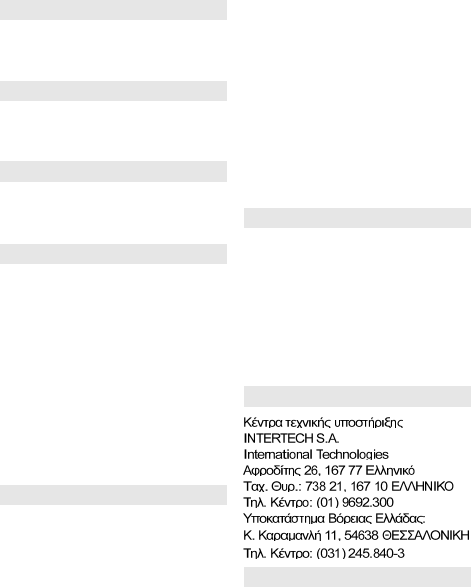
EU Warranty
101
MEGAFIX KY
Louhenkatu 9
74100 Iisalmi
Puh. +358 017 14631
T: MI.M.HAAPOJA
Miilukatu 7
40320 Jyväskylä
Puh. +358 014 677121
OUTOKUMMUN PUHELIN Pohjoisahonkatu 9
83500 Outokumpu
Puh. +358 013 562211
SETELE OY
Rengastie 31
60100 Seinäjoki
Puh. +358 06 4148344
TURUN J-MARKKINAT OY Tuureporinkatu 6
20100 Turku
Puh. + 358 02 2332685
N
Servicesenter I Norge
Norsk Elektronikksenter
Fetveien 1
2007 Kjeller
Tlf: +47 63 80 45 00
Panasonic Norge AS
Østre Aker vei 22
0508 Oslo
Tlf: +47 22 91 68 00
GR
P
Centros de Assistência em Portugal
PAPELACO, S.A.
Vale Paraiso - Ferreiras
8200 ALBUFEIRA
ALGARVE
Tel. +351 89 589960
PAPELACO, S.A.
Largo de Santos, 9
1200 LISBOA
Fonweg 60
2516 BM
Den-Haag
Nederland
Tel. +31 703314314
I
Per I Centri Assisitenza in Italia
Servizio Clienti
Tel. +39 02/ 67072556
E
Panasonic España, S.A.
Servicio de Atención a Usuarios:
Tel: 902 15 30 60
DK
For nærmeste servicecenter ring Panasonic
Danmark
Tel. +45 43 20 08 50
S
Firmor I Sverige
Komrep
Rosenlundsgatan 4
411 20 Göteborg
Tel. +46 031-173354
Signalstyrkan
Kungsholmstorg 4
104 22 Stockholm
Tel. +46 08-6542500
CR service
Industribyn 3
232 37 Malmö
Tel. +46 040-430030
SF
Huoltokeskukset Suomessa:
KAUKOMARKKINAT OY
PANASONIC-HUOLLOT Kutojantie 4
02630 Espoo
Puh. +358 09 521 5151 Huolto
Puh. +358 09 521 5155 Varaosat Ja Tarvikkeet
SETELE OY
Vanha Viertotie 7
00300 Helsinki
Puh. +358 09 549100
PLAY-SHOP SERVICE Keskuskatu 3
00100 Helsinki
Puh. +358 09 27053626
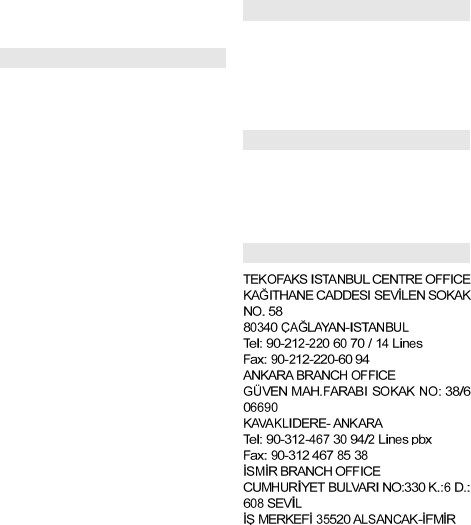
EU Warranty
102
Tel. +351 1 3970539
PAPELACO, S.A.
Largo do Tribunal, Lote 11
2400 LEIRIA
Tel. +351 44 28071
PAPELACO, S.A.
Rua Cidade de Santos, 31R/C
9000 FUNCHAL
MADEIRA
Tel. +351 91 231523
PAPELACO, S.A.
Rua do Outeiro,
Lote 25 - Gemunde
4470 MAIA
PORTO
Tel. +351 2 944 0354/9
PAPELACO, S.A.
Rua Major Leopoldo da Silva,
Lote 3
3500 VISEU
Tel. +351 32 424771
B
Centres de service après-vente en Belgique
BROOTHAERS
Hoevelei 167
2630 AARTSELAAR
Tel. +32 03/887 06 24
HENROTTE
Rue du Campinaire 154
6240 FARCIENNES
Tel. +32 071/39 62 90
PIXEL VIDEOTECH
Rue St Remy 7
4000 LIEGE
Tel. +32 041/23 46 26
DELTA ELECTRONICS
Rue P.d’Alouette 39
5100 NANINNE
Tel. +32 081/40 21 67
ELEKSERVICE FEYS Houthulstseweg 56
8920 POELKAPELLE
Tel. + 32 057/48 96 37
AVS WAASLAND Lavendelstraat 113
9100 ST NIKLAAS
Tel. +32 03/777 99 64
A.V.T.C SA
Kleine Winkellaan 54
1853 STROMBEEK-BEVER Tel. + 32 02/267
40 19
RADIO RESEARCH
Rue des Carmélites 123
1180 BRUXELLES
Tel. +32 02/345 68 56
VIDEO TECHNICAL SERVICE
Av. du Roi Albert 207
1080 BRUXELLES
Tel. +32 02/465 33 10
SERVICE CENTER Kapellestraat 95
9800 DEINFE
Tel. +32 09/386 67 67
TOP SERVICE
Westerloseweg 10
2440 GEEL
Tel. +32 014/54 67 24
TELECTRO SC
Quai des Ardennes 50
4020 Liège
Tel. +32 041/43 29 04
L
Centres de service après-vente au Luxembourg
NOUVELLE CENTRAL RADIO
Rue des Jones 15
L - 1818 Howald
Luxembourg - Grand Duché
Tel. +32 40 40 78
CH
Jonh Lay Electronics AG
Littauerboden
6014 Littau
Phone: +41 41 259 9090 Fax: +41 41 252
0202
TR
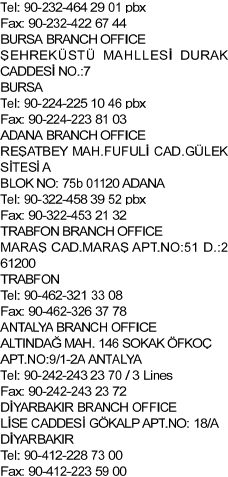
EU Warranty
103
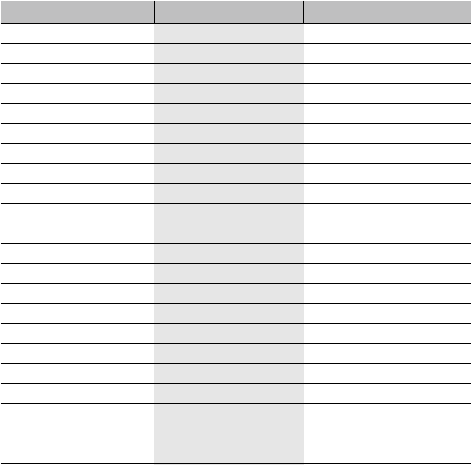
Personal Settings
104
Personal Settings
Use the table below to record your GSM/GPRS WAP settings.
Item Hint Current Setting
Name
Home URL
Gateway IP
Primary IP
Secondary IP
Primary Port
Secondary Port
CSD
GPRS
Line Type Analogue / ISDN
Digital Dial #
Analogue Dial #
User Name
Password
Transfer Rate
GPRS
Access Point Name
User Name
User Password
Authentication Normal/Encrypted/
None
(PAP) (Chap)
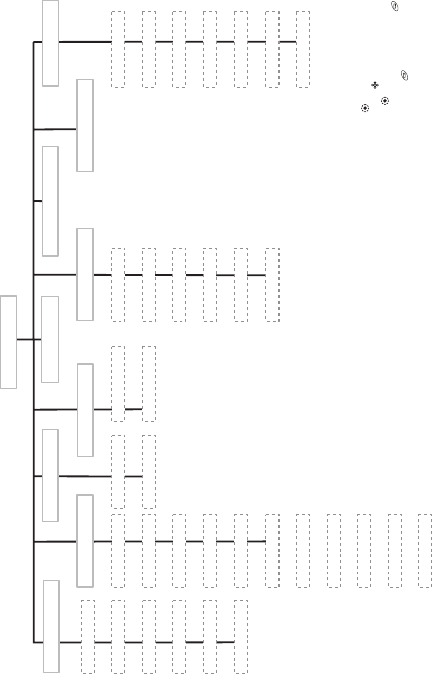
Menu Structure
105
Menu Structure
1. My Phone
2. Phone Book
3. Games
4. Browser
5. Key Guard
6. Messages
7. SIM Dependent
8. Scheduler
9. Applications
IDLE SCREEN
>> Indicates there are further submenus
From Idle press to display the main menu.
To select a menu, use to navigate to the icon of the menu you
require and press when the icon is highlighted. To exit the curren
t
menu and return to the previous level, press . To exit the menu
structure, press and hold .
During a call a restricted menu will be available.
Language >>
Sound Settings >>
Display Settings >>
Media Folder >>
Auto Answer >>
Defaults
Browse >>
Create >>
Group Setting >>
Review >>
Copy Entries >>
My Numbers >>
Info Numbers >>
Service Dial >>
Fixed Dial >>
Voicemail
Hot Key Dial List
PinBall
Black Jack
Start Browser
Browser Setting >>
Inbox
Outbox
Create
Chat SMS
Broadcasts
Options >>
Games
Voice Memo Play
Record
Clock Function >>
Calculator
Edit Ringtone >>
Phone Option >>
Note
106
Note

Licensing
107
Licensing
Tegic
T9® is a trademark of Tegic Communications Inc.T9® Text Input is licensed
under one or more of the following: U.S. Pat. Nos. 5,818,437, 5,953,
541, 5,187,480, 5,945,928, and 6,011,554; Canadian Pat. No. 1,331,057;
United Kingdom Pat. No. 2238414B; Hong Kong Standard Pat.
No.HK0940329; Republic of Singapore Pat. No. 51383; Euro. Pat. No. 0
842 463 (96927260.8) DE/DK, FI, FR, IT, NL, PT.ES, SE, GB; and addi-
tional patents are pending worldwide.
© Matsushita Mobile Communications Development of Europe Ltd 2003
Information in this document is subject to change without notice. No
part of these instructions may be reproduced or transmitted in any form
or by any means without obtaining express permission from Matsushita
Mobile Communications Development of Europe Ltd
Licensing
108
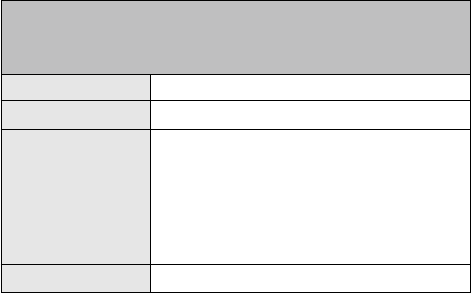
The Serial Number can be found on the outside of the phone under
the battery. For your convenience we recommend that you note the
following details as a record of your purchase.
Part Number
Serial Number
Dealer Name
Purchase Date

Matsushita Communication Industrial Corporation of the Philippines
Laguna Technopark Sta. Rosa, Laguna, Philippines
Printed in Philippines
08.07.02